
APRIL 2024 30 HOMEBUILT DIDI 23 34 KIRSTEN NEUSCHÄFER INTERVIEW, PART 1 38 PASSING CAPE CAUTION


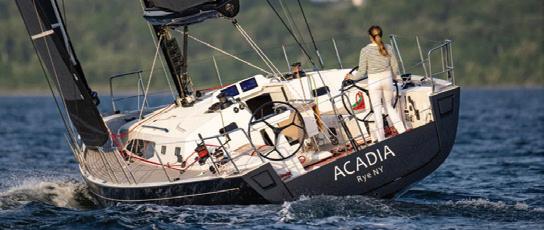
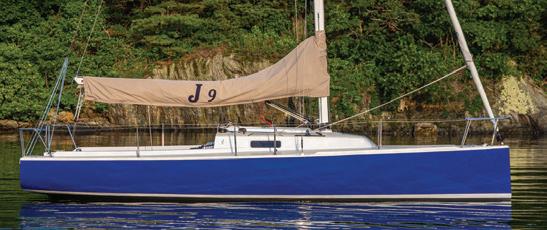








1996 43’ J/130 • $159,000 This has to be the nicest and best equipped J/130 ever. Newer sails, electronics, sat TVs, dodger and much more. She is a must see and at our dock. 2020 32’ J/99 • $279,000 Dash is offshore ready for the next Hawaii race, Newport Bermuda, or a Northwest cruise. She is equipped for double handed or fully crewed ocean racing. Just bring provisions and a first aid kit and you’re ready to go. J/45 • Early 2025 Delivery Available J/112e • Family Cruising In Comfort & Style J/Sport - J/70 J/80 J/88 J/9 J/99 J/111 J/121 J/Elegant - J/112e J/122e J/45 MJM Series Yachts MJM 3, MJM 35, MJM 4, MJM 42 Shilshole Marina Sales Office • www.sailnorthwest.com • 206-286-1004 Brokerage Boats • We Are Selling Boats and Need Listings NEW J/BOATS • 2024 Delivery Slots Available MJM 35 • On Display At Our Shilshole Location J/9 • Hull #52 On Order For Spring Delivery 2 J/40s 1986 & 1987 from • $54,000 Comfort & Speed For Couples That Cruise Across Oceans. The J/40 was the first bluewater offshore cruising boat built by J/Boats. 1999 36’ C&C 110 • $99,000 Cruise ready 3 cabin performance cruiser. Easy to sail and a comfortable cruiser with Webasto Heater and a Macerator head she is ready to go. 1992 J/35c • $79,000 Updated popular cruising J/Boat. Newer cushions, main cover, cockpit cushions, dodger and more. She is available for lease back in the Seattle Sailing Club. Sailnorthwest.com • 206-286-1004 • sales@sailnorthwest.com


La Paz, Mexico
Take the next step in your sailing adventures with our Cruise N Learn (ASA 103 + ASA 104 combo) sailing lessons in La Paz, Mexico! Escape the rain and cold this winter on these full immersion courses on the Sea of Cortez!
Anacortes, WA
Sail the gorgeous San Juan Islands on our liveaboard Cruise N Learn (ASA 103 + ASA 104 combo) or ASA 104 Bareboat Chartering class! Take your skills to the next level and get certified to skipper boats up to 45 feet!
Seattle, WA
Located in Shilshole Marina, our docks face the gorgeous Olympic mountain range. We offer lessons for all sailors, from beginners to experts. Come visit us to learn more about classes and membership, or browse our Pro Shop!



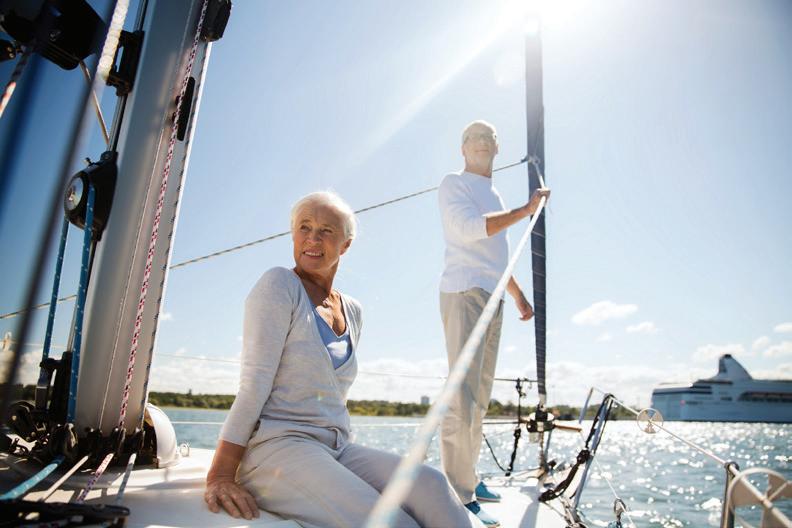



SEATTLE Sailing Club BOOK NOW! 7001 Seaview Ave NW Ste 130 206-782-5100 www.seattlesailing.com
Manual & Electric Options
Performa Winches
Performa Winches
Performa Winches
Performa Winches
Now through April 15 Winch
Sale
Winch Sale
Manual & Electric Options
Now
Performa winches combine the high-efficiency of the Radial line with the sandblasted grip of Harken carbon-fiber racing winches for powerful hybrids. Optimized to handle the high-strength line used on sportboats and performance cruisers, Performa winches are a great solution for crew who don’t wish to invest in carbon winches or who need racing winches in smaller sizes. Winches come in self-tailing, plain-top, or Quattro styles; manual, electric (12 volt or 24 volt), or hydraulic drives.
Performa winches combine the high-efficiency of the Radial line with the sandblasted grip of Harken carbon-fiber racing winches for powerful hybrids. Optimized to handle the high-strength line used on sportboats and performance cruisers, Performa winches are a great solution for crew who don’t wish to invest in carbon winches or who need racing winches in smaller sizes. Winches come in self-tailing, plain-top, or Quattro styles; manual, electric (12 volt or 24 volt), or hydraulic drives.
Performa winches combine the high-efficiency of the Radial line with the sandblasted grip of Harken carbon-fiber racing winches for powerful hybrids. Optimized to handle the high-strength line used on sportboats and performance cruisers, Performa winches are a great solution for crew who don’t wish to invest in carbon winches or who need racing winches in smaller sizes. Winches come in self-tailing, plain-top, or Quattro styles; manual, electric (12 volt or 24 volt), or hydraulic drives.
Performa winches combine the high-efficiency of the Radial line with the sandblasted grip of Harken carbon-fiber racing winches for powerful hybrids. Optimized to handle the high-strength line used on sportboats and performance cruisers, Performa winches are a great solution for crew who don’t wish to invest in carbon winches or who need racing winches in smaller sizes. Winches come in self-tailing, plain-top, or Quattro styles; manual, electric (12 volt or 24 volt), or hydraulic drives.
Radial Winches
Radial Winches
Radial Winches
Radial Winches
Radial Line winches successfully balance the need for a secure grip and line longevity with smooth, controlled easing while under load. These smaller winches can carry higher loads along with stress-free seasonal maintenance, and one-person installation with easy upgrades to power.
Radial Line winches successfully balance the need for a secure grip and line longevity with smooth, controlled easing while under load. These smaller winches can carry higher loads along with stress-free seasonal maintenance, and one-person installation with easy upgrades to power.
Radial Line winches successfully balance the need for a secure grip and line longevity with smooth, controlled easing while under load. These smaller winches can carry higher loads along with stress-free seasonal maintenance, and one-person installation with easy upgrades to power.
Radial Line winches successfully balance the need for a secure grip and line longevity with smooth, controlled easing while under load. These smaller winches can carry higher loads along with stress-free seasonal maintenance, and one-person installation with easy upgrades to power.


BE A HERO TO YOUR CREW!
BE A HERO TO YOUR CREW!
Manual-to-Powered Winch
BE A HERO TO YOUR CREW!
BE A HERO TO YOUR CREW!
Conversion Kits For Radial Winches
Manual-to-Powered Winch Conversion Kits For Radial Winches
Manual-to-Powered Winch
Manual-to-Powered Winch
Conversion Kits For Radial Winches
Up front, Harken manual winches are designed so that when you’re ready for power, they are too. Harken conversion kits simplify the process too. Most everything, apart from the electricity itself, your marine professional needs to power your winches comes in the kit.
Conversion Kits For Radial Winches
Up front, Harken manual winches are designed so that when you’re ready for power, they are too. Harken conversion kits simplify the process too. Most everything, apart from the electricity itself, your marine professional needs to power your winches comes in the kit.
Up front, Harken manual winches are designed so that when you’re ready for power, they are too. Harken conversion kits simplify the process too. Most everything, apart from the electricity itself, your marine professional needs to power your winches comes in the kit.
Up front, Harken manual winches are designed so that when you’re ready for power, they are too. Harken conversion kits simplify the process too. Most everything, apart from the electricity itself, your marine professional needs to power your winches comes in the kit.
BEFORE AFTER
BEFORE AFTER

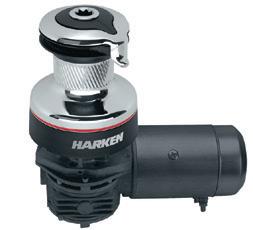
48º NORTH 4 APRIL 2024 Call us 800.426.6930 1900 N. Northlake Way, Seattle FisheriesSupply.com
& Electric Options Now through April 15 Winch Sale
Manual
Call us 800.426.6930 1900 N. Northlake Way, Seattle FisheriesSupply.com Manual & Electric Options Now through April 15 Winch Sale
Call us 800.426.6930 1900 N. Northlake Way, Seattle FisheriesSupply.com
through April 15
BEFORE AFTER Call us 800.426.6930 1900 N. Northlake Way, Seattle FisheriesSupply.com
CONTENTS
FEATURES
34 High Seas Adventurer: Kirsten Neuschäfer, Part 1
An interview with the winner of the Golden Globe Race.
By Joe Cline
38 Passing Cape Caution
Getting to and around this infamously challenging headland.
By William Kelly and Anne Vipond
COLUMNS
20 Youth Sailing Beat: Getting into Youth Sailing
A helpful overview with information for parents.
By Solvig Sayre
24 Diesel Deep Dive: Saildrive or Direct Drive
A mechanic’s look at the pros and cons of these two systems.
By Meredith Anderson
26

Hikes for Boaters: South Puget Sound
Get your steps at Jarrell Cove, and Hope and Anderson islands.
By Michael Boyd
30 My Boat: Homebuilt Didi 23, Koru
A versatile family boat for a small boat builder on Bainbridge.
RACING
42 Gig Harbor Islands Race
Spring sun to round out this winter’s Southern Sound Series.
44 Type II Entertainment: Girts Rekevics Memorial Rain squalls, standing waves, and a new course record.
46 Blowing Dogs Off Chains: Center Sound Series
Possibly the windiest-ever start to CYC Seattle’s March series.
48º NORTH 5 APRIL 2024
ON THE COVER: We sail in a beautiful place! Two J/109s—David Schutte’s Spyhop and Kirk Fraser’s Eclipse —charge to weather during the first Center Sound Series race to Blakely Rock. Sadly, Eclipse would lose its rig during the second race of the series the following weekend (page 46). Photo by Jan Anderson.
APRIL 2024
Background photo courtesy of Jan Anderson.
Editor
THE SPIRIT OF ADVENTURE 6
There are a lot of ways to think about the time we spend on the water. For some, it’s relaxation away from it all. For others, a lifelong learning experience. Maybe it’s a test of your skills, a joyful (or serious) competition, or a meditative practice of living in the moment. It can be all of the above, or any of the infinite list of other perspectives about this experience we’re passionate about.
Recently, I’ve been compelled by stories that frame on-the-water experiences as adventures. It is top of mind this month because I got to sit down with one of the world’s great adventurers, Kirsten Neuschäfer. Kirsten is an extraordinary South African sailor who won the “retro” Golden Globe Race in 2023 on her Port Townsendbuilt Cape George 36. Retro, in this case, refers to the limited technology sailors were allowed—no GPS or modern weather information on smaller, older boats.
Kirsten is particularly notable because she won the race, but I was doubly impressed to learn about her profound competence with boats and offshore sailing, the ways she leans into to things many would shy away from, and her commitment to adventure which she says is “the thing that enthuses me most in life.” She defines adventure broadly, and pursues these activities with enthusiasm and aplomb—whether riding her bike across Africa from north to south, or logging more than 15,000 solo ocean miles on the new-to-her Cape George 36 (Canada-South Africa-France) before she even got to the start line of the race she would eventually win. Yes, this prepared her and let her know how to ready her boat for the race; but getting to know Kirsten for even a few hours, I feel certain she was primarily keen for the adventure of it all.
Most of us won’t be solo circumnavigators, let alone win a race around the globe. So it can seem counterintuitive—it doesn’t necessarily feel adventurous to day sail waters you know well in gentle breeze and sunshine. Still, it may be less about the facts and more about the mindset, and any trip away from your slip may become adventurous thanks to wildlife, weather, personal experience, or a problem that arises with your boat. Of course, each edition of this magazine and any sailor’s mind is filled with stories at the other end of the spectrum—more intense, more exciting, more conventionally adventurous (like, say, rounding Cape Caution, page 34, or racing on Puget Sound when a 50-knot cell comes through, page 46).
The important thing is to recognize that when we hear about adventure sailing or adventure racing, we might be defining those experiences too narrowly. What sailing isn’t adventure sailing? And what racing isn’t adventure racing? It’s not to take anything away from those resilient folks who take on the challenges of more traditionally-defined adventures. I’m just suggesting that broadening the definition and using a lens of adventure to view our time afloat in the Pacific Northwest and beyond may deepen our experience, our appreciation of the environment in which we adventure, and the people with whom we share it.
All of us at 48° North want to say a truly heartfelt THANK YOU to each person who donated to 48° North in the last month. It has been humbling, invigorating, and rewarding to see this tangible and generous expression of support from so many people who believe in what we do. We are beyond grateful and inspired to carry on the work of 48° North with your help!
I’ll see you on the water,
Joe Cline Managing Editor, 48° North
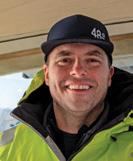
Volume XLIII, Number 9, April 2024 (206) 789-7350
info@48north.com | www.48north.com
Publisher Northwest Maritime Center
Managing Editor Joe Cline joe@48north.com
Editor Andy Cross andy@48north.com
Designer Rainier Powers rainier@48north.com
Advertising Sales Kachele Yelaca kachele@48north.com
Classifieds
classads48@48north.com
Photographer Jan Anderson
48° North is published as a project of the Northwest Maritime Center in Port Townsend, WA – a 501(c)3 non-profit organization whose mission is to engage and educate people of all generations in traditional and contemporary maritime life, in a spirit of adventure and discovery.
Northwest Maritime Center: 431 Water St, Port Townsend, WA 98368 (360) 385-3628
48° North encourages letters, photographs, manuscripts, burgees, and bribes. Emailed manuscripts and high quality digital images are best!
We are not responsible for unsolicited materials. Articles express the author’s thoughts and may not reflect the opinions of the magazine. Reprinting in whole or part is expressly forbidden except by permission from the editor.
SUBSCRIPTION OPTIONS FOR 2024!
$39/Year For The Magazine $75/Year For Premium (perks!)
www.48north.com/subscribe for details.
Prices vary for international or first class.
Proud members:
48º NORTH 6 APRIL 2024












✓ Items not available anywhere else. ✓ One-stop resource with deep inventory. ✓ Easy-to-reach technical sales staff. ✓ Extensive free how-to content. ✓ Competitive pricing. ✓ Quick shipping. ✓ FREE shipping over $199*. Everything you need. All in one place. ©2023 Sailrite Enterprises, Inc. *No promo code necessary. Free FedEx ® Ground shipping to the 48 contiguous United States only (excludes AK, HI and PR). Order subtotal must be $199 or more before tax and shipping to receive offer. Offer not valid on prior purchases. Does not apply to trade accounts. Some exclusions apply. Equipping you to sew since 1969 | Visit us at Sailrite.com YOUR #1 DIY RESOURCE INDOOR/OUTDOOR VINYL INDOOR/OUTDOOR VINYL INDOOR/OUTDOOR VINYL
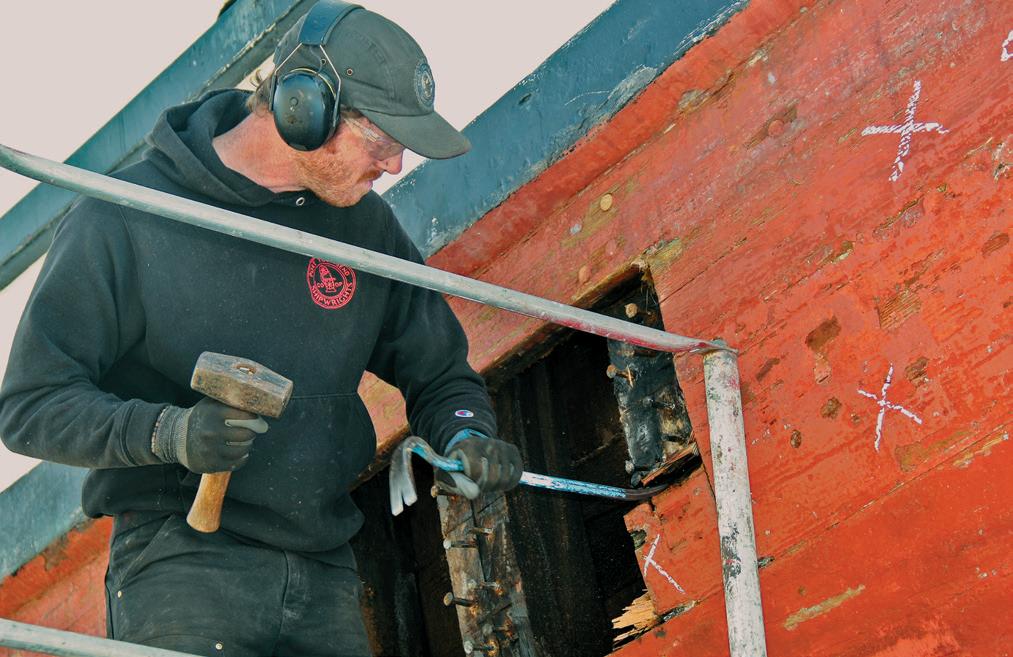


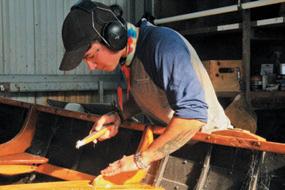


48º NORTH 8 APRIL 2024
RACE! PARTY! PLAY!

June 24-28, 2024 l RaceWeekPNW.com
ORC, PHRF, One Design, Cruising Class
FUN!
SUNDAY JUNE 23
SkipperS Meeting & OPENING NIGHT PARTY Featuring aaron CrawFord
MONDAY JUNE 24
raCing Followed by JIMMY BUFFETT NIGHT Featuring dJ Mark JenkinS
TUESDAY JUNE 25
raCing Followed by REGGAE NIGHT Featuring dJ Mark JenkinS
WEDNESDAY JUNE 26
raCing Followed by PRETTY IN PINK NIGHT
Featuring gertrude’S HearSe
THURSDAY JUNE 27
raCing Followed by ABBA NIGHT Featuring tHe abbagrapHS
FRIDAY JUNE 28
raCing Followed by OVERALL AWARDS Featuring SJatr

"Race Week in Anacortes exceeded our expectations in every way."
Spencer Kunath, Navigator TP52 Glory
















48º NORTH 9 APRIL 2024
REGISTRATION NOW OPEN!
Photos by Jan Anderson

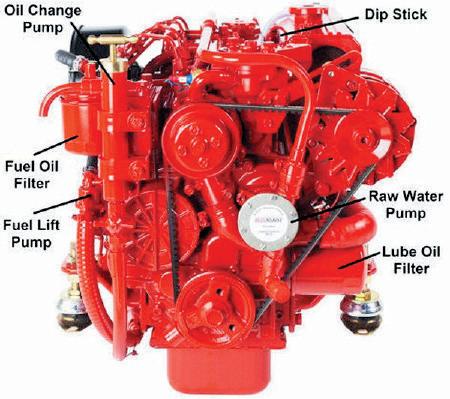
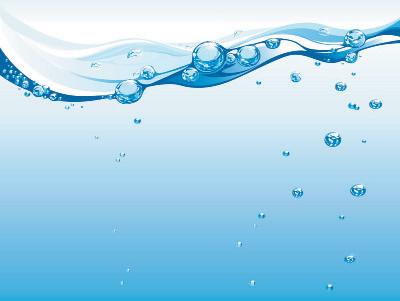
Beta Marine West (Distributor)
400 Harbor Dr, Sausalito, CA 94965 415-332-3507
Pacific Northwest Dealer Network
Emerald Marine Anacortes, WA • 360-293-4161 www.emeraldmarine.com
Oregon Marine Industries Portland, OR • 503-702-0123 info@betamarineoregon.com
Access Marine Seattle, WA • 206-819-2439 info@betamarineengines.com www.betamarineengines.com
Sea Marine Port Townsend, WA • 360-385-4000 info@betamarinepnw.com www.betamarinepnw.com
Deer Harbor Boatworks Deer Harbor, WA • 844-792-2382 customersupport@betamarinenw.com www.betamarinenw.com
Auxiliary Engine
6701 Seaview Ave NW, Seattle WA 98117 206-789-8496
auxiliaryeng@gmail.com
Hi Joe,
Do you know who David Linger is? He’s a long-time Seattle Corinthian Yacht Club guy doing the Global Solo Challenge. Currently he’s in 6th place with about a 50% attrition rate in the fleet.
Dave’s a low key kind of guy that doesn’t make a lot of “noise”. He’s sailing off the coast of Argentina northbound for the finish. He is one of the most competent sailors I’ve ever sailed with.
I think Dave needs some love from the local crowd and a little recognition from the magazine. You can follow David and learn more at: www.globalsolochallenge.com
Thanks,
Jack Spriggs
Getting More Folks on the Water
Hello 48° North,
Well Joe, you had me with your first sentence of your editorial in the January 2024 issue: “I spend an inordinate amount of time thinking about increasing participation in sailing and boating.”
I’m a lifetime sailor, currently a sailing instructor at the Center for Wooden Boats, and also teach a class there in small craft (camp) cruising—my main joy for the last 15-20 years.
My focus the last several years has been to establish a small craft cruising community here, in and around the Seattle, Everett, Tacoma areas. Progress has been slow. I want it to happen.
Lee Bjorklund
Social Media Response to Jennifer Dalton’s March Article “The Dreaded Lopez Channel”
Tom Andrewes: That’s the problem in summer. The high tides are only in the evening or later. I have never seen the infamous rock. The channel does change depths in different spots. Good story.
Tony Norris: How else are you going to get those barnies off the bottom of the keel?
Correction to March Issue:
The Toliva Shoal Race results were updated the day after we went to press, and the final standings now show that Bob King’s Olson 40, String Theory, actually won the Overall in this year’s edition of Toliva Shoal. We had written in the March issue that Bob and crew placed second overall for the day. Well done!
48º NORTH 10 APRIL 2024
10
the
Engineered to be Serviced Easily!
LETTERS
All
Power You Need
Model Shown Beta 38
PNWer David Linger In Final Push of Global Solo Challenge
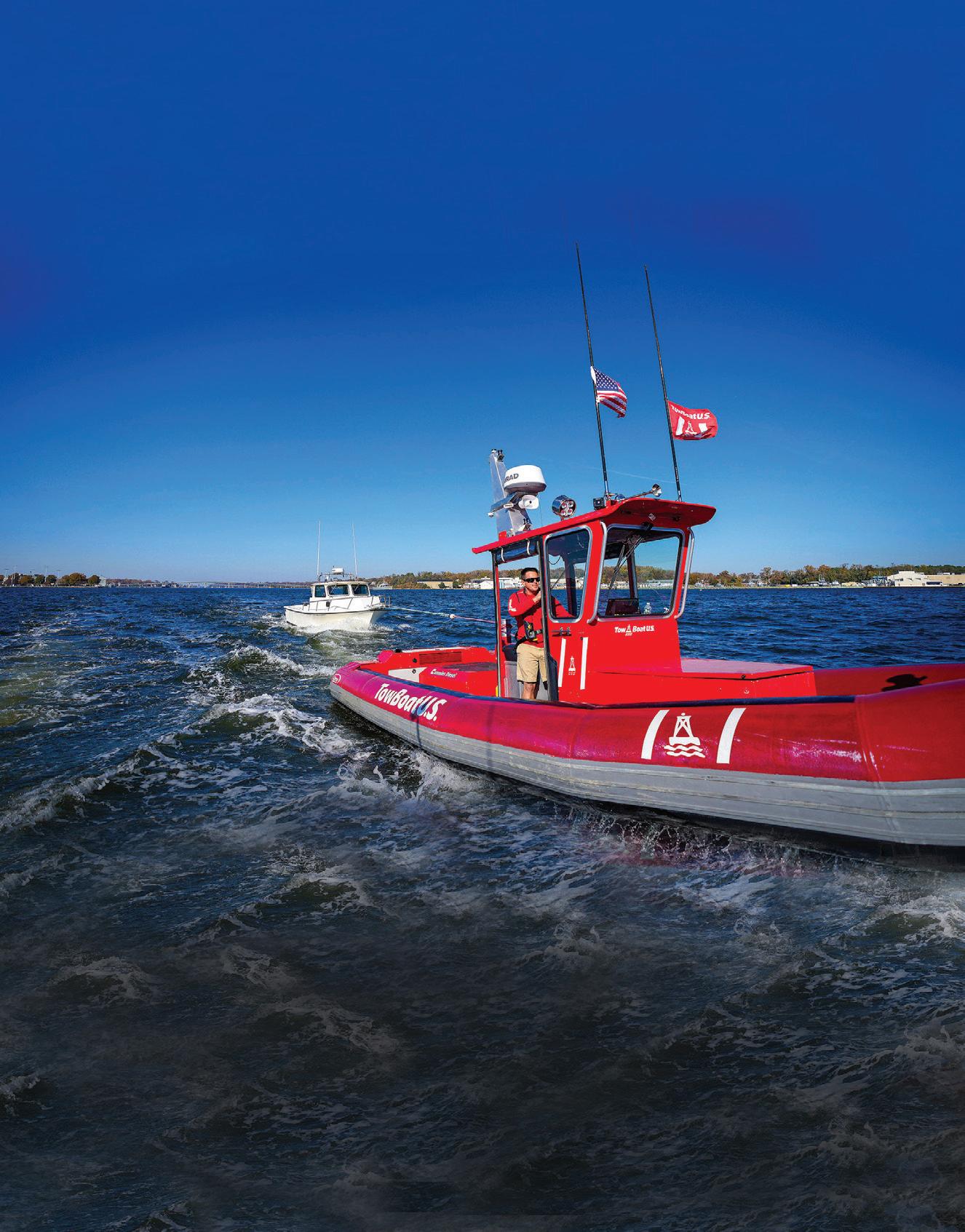
worry-free boating why get towing? Breakdowns are unpredictable but with an Unlimited Towing Membership, we promise to have your back should the unexpected happen. Sit back, relax and enjoy your time on the water worry-free. GET TOWING & GET GOING BoatUS.com/Towing Details of services provided can be found online at BoatUS.com/Agree. TowBoatU.S. is not a rescue service. In an emergency situation, you must contact the Coast Guard or a government agency immediately.

Three Long Courses for Monohulls and Multihulls
• Swiftsure Lightship Classic, PHRF NW
• Cape Flattery, PHRF NW & ORC
• Juan de Fuca, Monohull & Multihull, PHRF NW
Inshore Courses for Racing and Cruising
• Inshore Courses, PHRF BC
REGISTRATION OPENS
Friday March 1st, 2024 • swiftsure.org/ registration
48º NORTH 12 APRIL 2024 Official Sailmaker of the Swiftsure International Yacht Race
MAY 25–26, 2024
Photo by Wendi Donaldson Laird
swiftsure.org #swiftsure
I NTER NATI ONAL YACHT R ACE
MARINE TR TAC RECREATIONAL COMMERCIAL INDUSTRIAL MARINE INSURANCE BROKERS presents Royal Victoria Yacht Club C
SWIF TSURE 2024
News from the Northwest Maritime Center >>
48° North has been published by the Northwest Maritime Center (NWMC) since 2018. We are continually amazed and inspired by the important work of our colleagues and organization, and dedicate this page to sharing more about these activities with you. 48° North is part of something bigger, and we believe the mission-minded efforts of our organization matter to our readers.
WA360 ADVENTURE RACE RETURNS SUMMER 2025,
RACE TO ALASKA TO ALTERNATE ON EVEN YEARS
WA360 (pronounced Washington Three Sixty) will return next summer. WA360 is 360 miles of engineless, unsupported boat racing through the best, worst, and most diverse water puzzles Washington State offers. The race will start and end in Port Townsend, traveling counterclockwise through the waterways of Washington within spitting distance of dozens of Pacific Northwest communities.
WA360 debuted in 2021 with 56 teams who made the run in catamarans, trimarans, monohulls, kayaks, SUPs, surfskis, and some weird pedal-boat thing, all competing in one of three classes: Go Fast, Go Hard, and Human Power. The 2025 edition of the race will include a fourth class for youth participants.
Specifics of the 2025 WA360 race, including start date and route, will be announced at the Race to Alaska Blazer Party held on the Friday of Wooden Boat Festival in September in Port Townsend (then revealed online sometime shortly thereafter).
“WA360 is always a paper airplane’s throw away from a Puget Sound community,” said Jesse Wiegel, Race Boss at the Northwest Maritime Center. “It’s an incredible platform for your wildest on-the-water dreams. WA360 provides an accessible and exciting way to level up your nautical adventure game here in our own backyard.”
EVENTS CALENDAR » www.nwmaritime.org/events
DEADLINE TO APPLY FOR
SEVENTY48: April 1, 2024
R2AK: April 15, 2024
Online
BOAT BUYING BASICS
April 30 - May 1, 2024
Virtual Class
MHS 11th GRADERS EARN MERCHANT MARINER CREDENTIALS
Eighteen 11th-graders participating in the Maritime High School (MHS) Vessel Operations, Design, and Maintenance pathway in partnership with Seattle Maritime Academy (SMA) have been transformed from enthusiastic maritime novices into emerging professionals complete with Basic Safety Training, First Aid Certification, firefighting experience, and their Transportation Workers Identification Credential (TWIC) cards. This winter, they learned how to serve as deckhands aboard SMA's training vessel the Maritime Instructor, and practiced tracing and diagramming ship systems and turning on an onboard fire system independently.
Next year, the senior class will dive into vessel engineering— including diesel mechanics and marine electrical systems. In June 2025, the first MHS graduates will set out with their high school diploma and their QMED, giving them access to entrylevel jobs earning $70k a year. Many will likely choose to connect directly with maritime employers soon!
» nwmaritime.org/maritime-high-school
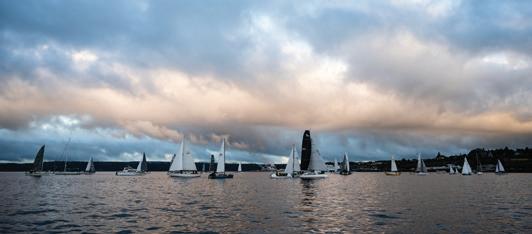
RACE TO ALASKA STARTS BIENNIAL SCHEDULE
After the 2024 Race to Alaska, the race will assume a biennial (every-other-year) schedule, alternating with WA360. Race to Alaska will run in even years, and WA360 will run in odd years. The 2024 race starts on Sunday, June 9, 2024; the application deadline for 2024 is April 15.
Both WA30 and Race to Alaska are projects of the Northwest Maritime Center, a 501(c)3 non-profit organization based in Port Townsend, Washington, whose mission is to engage and educate people of all generations in traditional and contemporary maritime life, in a spirit of adventure and discovery.
» nwmaritime.org/wa360-race
OUTBOARDS: MAINTENANCE, CARE, AND TROUBLESHOOTING
May 4, 2024
NWMC Boatshop
WOMEN'S BASIC KEELBOAT FULL COURSE
May 27-31, 2024
Port Townsend, WA
YOUR WOODEN BOAT HAS A STORY, AND THE WOODEN BOAT FESTIVAL IS THE PLACE TO TELL IT
Did you build your boat from the ground up or sail on one as a child before being reunited years later as an adult? The Port Townsend Wooden Boat Festival is the place to share, exchange, and explore these incredible tales. Tell these stories by exhibiting your boat in the upcoming Festival. The boat application is now live on the website! Apply now to showcase your boat at the 2024 Port Townsend Wooden Boat Festival.
Please APPLY EARLY—this will give you the best chance of being accepted into the Festival, which has sold out by June for the past several years! Returning boaters, please note that the application process has changed for 2024. To apply, you need a picture ready to upload and all the details of your boat.
This is also the time for vendors, musicians, food vendors, and seminar presenters to apply to be a part of this year's Wooden Boat Festival!
» woodenboat.org/register-your-boat
48º NORTH 13 APRIL 2024
Photo by Jeremy Johnson
low tides » News & Events
SPRING BOATS AFLOAT SHOW ON LAKE UNION IS APRIL 25-28
The Pacific Northwest’s largest spring boat show arrives in South Lake Union, April 25 - 28, 2024. Produced by the Northwest Yacht Brokers Association (NYBA), this annual fourday event is scheduled just in time to celebrate spring and kick off boating season.
This fun, family event has something for everyone of all ages, and kids 12 and under are free. Whether you’re actively looking for your next boat, or planning for a few years down the road, the Boats Afloat Show is a fun opportunity to step aboard some of the newest yachts on the market. Bring your best boating friends, your co-captain, your entire family. This year NYBA is bringing back their popular Women’s Day on Thursday, April 25th. All are welcome, but women receive special ticket pricing: $10 for tickets purchased online, or $11 for tickets purchased at the door, plus applicable taxes.
Single day tickets are available online, or at the entrance.
Adults: $20 online ($22 at the entrance) Teens: 13-17 $5. All Access Multi-Day Pass: $35 (exclusively sold online). Learn more or get tickets at:
» www.boatsafloatshow.com
FISHERIES SUPPLY SPRING SWAP MEET SET FOR APRIL 20
Join hundreds of your fellow boaters, bargain hunters, and deal makers to celebrate what has become a Pacific Northwest tradition. This ever-popular swap meet makes its glorious spring appearance on Saturday, April 20, from 6 a.m. to 12 p.m. in the Fisheries Supply parking lot (1900 N. Northlake Way, Seattle, WA).
It's a maritime flea market, full of boating goods, old parts, new parts, outboards, buoys, dock line, coolers, heaters, chain, clothing, and so much more. Die-hard bargain boaters have been known to arrive the night before to stake out a good parking spot, although sellers are not allowed to use the lower tier of the upper parking lot (closest to the store entrance). In addition to the hundreds of boaters buying, selling and trading boating equipment, Fisheries Supply will be offering reduced pricing on clearance, discontinued, overstock, scratch and dent products, and last season’s clothing.
» www.fisheriessupply.com/swap-meet
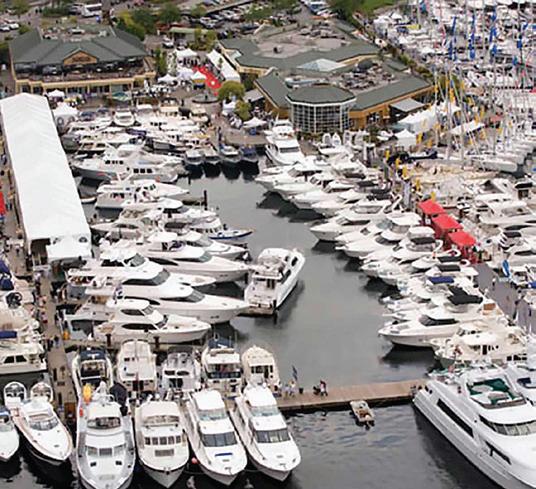
REGISTRATION OPEN FOR J/24 WORLDS IN SEATTLE
Registration for the 2024 J/24 World Championship presented by Beecher’s Handmade Cheese, to be sailed September 28-October 5, is open. Framed by snow-capped mountains, Puget Sound promises to provide picturesque and challenging conditions for the competitors on the water while the famed Pacific Northwest will provide plenty of activity off the water.
The host Seattle J/24 Fleet 26 has assembled an experienced and enthusiastic organizing committee that includes two-time world champion Keith Whittemore. Corinthian Yacht Club of Seattle, which is a veteran of many national and international championships over the decades, will be running races along with renowned Principal Race Officer Mark Foster. There will also be on-the-water judges. Entertainment and parties will be onsite, spectator boats will be available, and live video coverage is planned. Opening Ceremonies will be nearby at the Nordic Heritage Museum.
» www.j24worldsseattle.org
BUY OR SELL, THE MARINE THRIFT SWAP MEET IS COMING!
The Marine Thrift Swap Meet is coming to Port Townsend on Saturday, April 6 from 8 a.m. to 2 p.m. Join your fellow boaters at one of the PNW’s best bargain boating bazaars to stock up on used and useful tools, hardware, boat supplies, and more. Located at 315B Haines Place, Port Townsend, the Marine Thrift Swap Meet—organized by the Northwest Maritime Center—happens each April in Boat Haven in the gravel lot immediately adjacent to Marine Thrift.
Want to sell at the Swap Meet? Clean out your shop, empty your garage, and turn your old stuff into cash. It’s free to sell. Note that at the end of the day, you can donate your unsold items to Marine Thrift and get a tax-deductible receipt!
Each registrant will receive some space. Please bring your own setup materials such as tarps, tents, tables, etc. Setup starts no earlier than 7:00 a.m. and you must vacate by 3:00 p.m. Marine Thrift does not provide payment systems and there is no WiFi on site. Bring your own change and decide on your own credit card or check policies. Please register in advance so space can be planned accordingly.
» www.nwmaritime.org/marine-thrift/
48º NORTH 14 APRIL 2024

POINT HUDSON MARINA REOPENS AFTER $12M JETTY PROJECT
The Point Hudson jetties that form the breakwater for the Port of Port Townsend’s beautiful, historic marina are complete. After two winters of work by Orion Marine Group, the second (south) jetty was completed in February. Boats were invited back to their slips on March 1, 2024.
All boaters—visitors and permanent customers—will now enjoy decades of protection from easterly and southerly winds, along with an addition of about six feet of above-water protection against rising sea levels. That is something to celebrate, and the Port of Port Townsend plans to do so with a dedication ceremony at Point Hudson on April 24 from 1 p.m. to 3 p.m.
Both phases of the two-year project had to be managed within a narrow window between the end of the annual Wooden Boat Festival in early September, and protection of fish species that come through local waters in late February. Orion got the in-water portion done— which included working 24 hours a day, six days a week—through January and early February.
» www.portofpt.com
THE BOAT GEEKS PODCAST SETS SAIL
The Boat Geeks podcast, a new PNWbased media venture in the maritime world, is delighted to announce the official launch of a show that takes boating enthusiasts on an exciting journey through the high seas of conversations. Hosted by Daeron Katz and Darren O’Brien, The Boat Geeks podcast will deliver engaging and insightful content, covering a wide spectrum of topics related to boating. From recreational stories to industry insights, each episode promises to be a captivating voyage into the heart of maritime passion, available on video or as audio-only podcasts. The podcast is now available on popular platforms such as YouTube, Apple Podcasts, Spotify, and all major podcast players.
» www.theboatgeeks.com


48º NORTH 15 APRIL 2024 Mobile Fuel Polishing Serving The Entire Pacific Northwest • 360-808-0505 Seventh Wave Marine www.seventhwavemarine.com seventhwavemarine@olypen.com Fuel Filtering...Tank Cleaning (Water, Algae, Sludge and Particle Removal Service) Changing filters often? Don't let bad fuel or dirty tanks ruin your next cruise! Whether you're cruising the Pacific Northwest, heading for Alaska, Mexico or around the world, now is the time to filter your fuel & tank before trouble finds you out there! Anacortes, nestled in the Pacific Northwest, boasts stunning landscapes, a vibrant coastal community, and a rich maritime history.
ACROSS
CROSSWORD AND TRIVIA
DID YOU KNOW?
by Bryan Henry
What is the fastest thing in the ocean? It’s a tsunami, which can travel at speeds of 500 mph and create havoc thousands of miles away.
Before making landfall, a tsunami pulls millions of gallons of seawater away from the shore, leaving an exposed shelf that may extend several thousand feet.
The International Tsunami Warning System, based in Honolulu, was set up after the 1960 earthquake in Chile caused a massive tsunami that reached Japan in less than a day.
Some tsunamis can be 15 to 20 stories above sea level.
Since tsunami waves increase in size as they approach shallow water near shore, they can go from several yards in mid-ocean to 100 feet at the coast.
DOWN
The height of a wave is called amplitude, the distance between successive wave crests is known as wavelength, and the time between successive wave crests is the period.
The height of waves depends on the fetch, the distance the waves can run without meeting an obstacle.
Mareographs measure sea levels. Ripples, tiny waves a fraction of an inch high, are also called capillary waves.
While oceanography as a science has existed since 1847, less than 5 percent of the sea floor has been explored.
More than 90 percent of the world’s oceans are more than two miles deep.
The Mid-Atlantic Ridge, a mountain range stretching 10,000 miles under the Atlantic Ocean, is longer than the Himalaya, the Andes, and the Rockies combined. It wasn’t directly seen or explored until 1973.
Salinity of the oceans averages about one-half ounce of salt per pound of seawater.
48º NORTH 16 APRIL 2024
16
1 Exterior of a ship 3 Navigational instrument 8 Nautical direction 9 Adjusts the sails 11 Ship repair area 13 Lower the lights 15 Web site address ending 17 Fishing aid 19 Lures for fish 21 Back again 22 Stabilizer deployed in the water for heaving to in heavy weather, 2 words 24 Cargo wieght measurement 25 Raise 26 Baseball stat, abbr. 27 Slow a vessel’s forward progress, 2 words 31 Smooth 32 Completely ready for use on delivery 33 Welcome
1 Skipper’s place 2 Be stationary, at sea, 2 words 4 Veteran sailor, 2 words 5 Kitchen container 6 Finely divided water swept from the crest of waves by strong waves 7 _____ down the hatches 10 Strong vertical support for the ship’s windlass and the heel of a ship’s bowsprit, 2 words 12 Leaving a ship 14 Spar projecting from vessel head 16 Slowly moving mass of ice 18 And so forth 20 Rainbow ___ 23 Of great weight 28 Wide shoe fitting 29 Volumetric Efficiency, for short 30 “How about that!” 12 3 456 7 89 10 11 12 13 14 15 16 17 18 19 20 21 22 23 24 25 26 27 28 29 30 31 32 33 » See solution on page 50




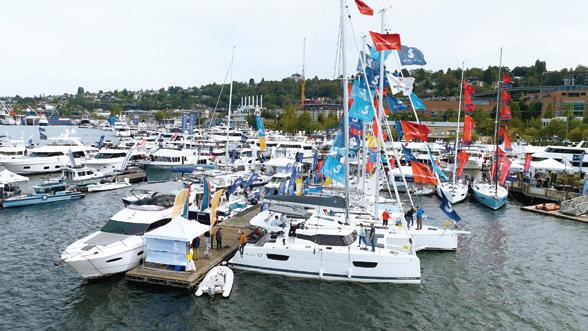
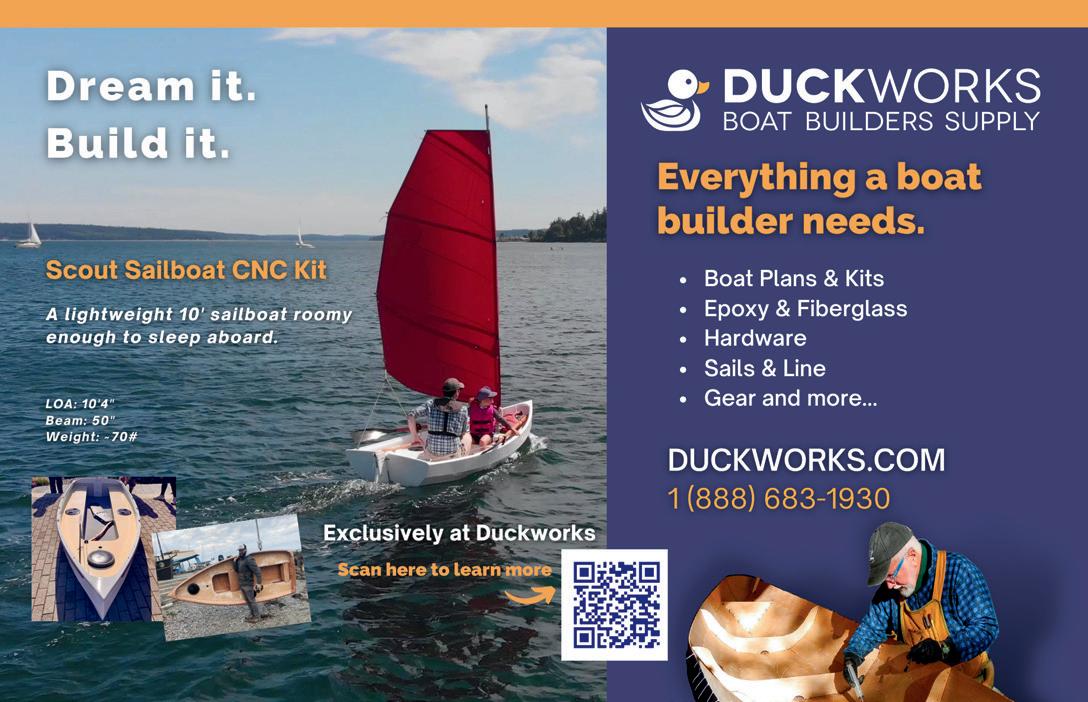
48º NORTH 17 APRIL 2024
low tides » Products News
» WEEMS & PLATH BRIGHTWIND
Knowing that real estate is limited on the top of the mast, Weems & Plath set out to create the world’s first ultrasonic wind sensor/LED triColor/LED anchor light combination—and they did it! Aptly named, BRIGHTWind, this unique, state-of-the-art pairing combines the ultra-low-powered, non-mechanical wind sensor (created by Spanish manufacturer, Calypso Instruments) with Weems & Plath’s powerful, yet energy efficient, LX TriColor/Anchor LED Navigation Light with Strobe and Photodiode. This combination was designed exclusively for sailors seeking unparalleled simplicity, safety, and precision on the water. BRIGHTWind will provide wind speed and direction data to any NMEA 0183 or NMEA 2000 display (with converter). Unlike many traditional wind sensors on the market, BRIGHTWind features no bearings or mechanical parts, instead using four ultrasonic transducers that measure how fast it takes for sound waves to travel back and forth between each transducer. The speed with which the sound waves travel is used by the sensor to determine the wind speed and direction.
Price $1,599.99 » www.Weems-Plath.com/BRIGHTWind
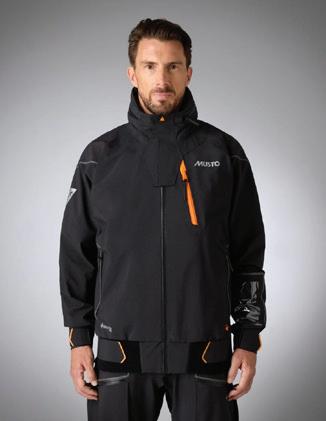
» SELDÉN WINCHES
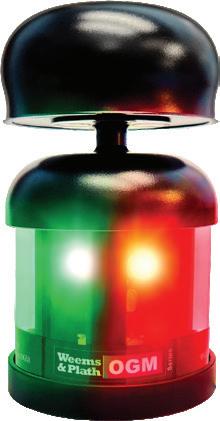
» MUSTO MPX GORE-TEX IMPACT JACKET
Built for maximum performance against the impact of rigorous offshore racing, this gore-tex sailing jacket provides optimized breathability and comes with a ‘guaranteed to keep you dry’ promise for waterproof protection in a totally windproof product. Musto’s new exclusive technology allows for a low profile, lightweight, flexible jacket that is waterproof without impacting on the fabric’s breathable properties. An easy-access waterproof phone pouch with a touchsensitive window is located on the forearm so you can use navigation or wind data apps. Laser cut pocket drainage prevents pooling, while YKK VISLON® AquaGuard® zippers provide rain and windproof closures. Chest and hand pockets are trimmed with reflective details for higher visibility in darker conditions. The hi-vis hood can pack away into the collar and there is an external hanging loop for storage. The outer funnel neck collar works against the whip of the wind and spray, while the inner PU coated collar stretches with an adjustable, elasticated tab for a comfortable and close fit against the skin. The hem of the jacket is finished with an adjustable neoprene skirt that, when closed tightly, prevents water rushing up.. Price: $1,150 » www.musto.com
Seldén Mast recently introduced an extensive range of new manual and electric selftailing winches that give extra attention to the drum and the self-tailer. The new winches were designed to obtain a strong grip, a smooth release, and the possibility to easily pull the slack straight out of the self-tailer with the winch handle fitted in the socket. The drums feature vertical ribs placed in an asymmetric order with uneven distances between the ribs. A line under load will deform over the ribs but when easing off the line over the Seldén drum, all indentations are not simultaneously reaching the next rib. The line will then have less tendency to “jump” out but will rather slide out with control. Seldén calls it Asymmetric Rib Technology (ART). The winches are built at Seldén’s plant in Sweden and consist of manually operated two-speed self-tailing winches in sizes 30-66 and electric winches in sizes 40-66. The electric winches are manual 2-speed winches fitted to a SEL-Bus driven motor pack allowing for a third high-speed velocity.
Price: $955+ » www.seldenmast.com
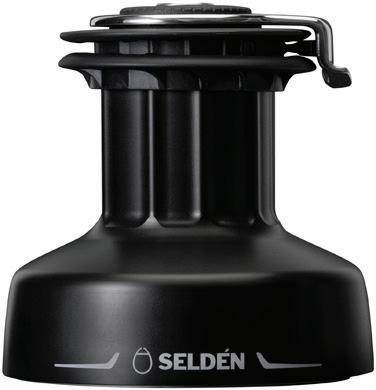
48º NORTH 18 APRIL 2024









48º NORTH 19 APRIL 2024 Cape George Marine Works Inc. 1924 Cape George Rd. Port Townsend, WA 98368 360.385.3412 Cape George 34 www.capegeorgecutters.com Ullman Sails • (360) 504-6640 9090 S March Point Road, Building C-200, Anacortes, WA 98221 Pnw.ullmansails.com ULLMAN SAILS Free Service pick up and delivery in Puget Sound area. Call us for information. GET TICKETS NOW WWW.ANACORTESBOATANDYACHTSHOW.COM Adventures Begin Here BOAT SHOW: MAY 16 - 18 SEMINARS: MAY 14 - 18 CAP SANTE MARINA ANACORTES, WA Discover new and brokerage boats from the top brands, dealers, and brokers, alongside accessories and services, all in one stunning location. Immerse yourself in expert boating seminars and evening rendezvous activities. It's the ultimate spring boating destination! Get your tickets today.
YOUTH SAILING BEAT 20 GETTING INTO YOUTH SAILING: A PARENT'S GUIDE
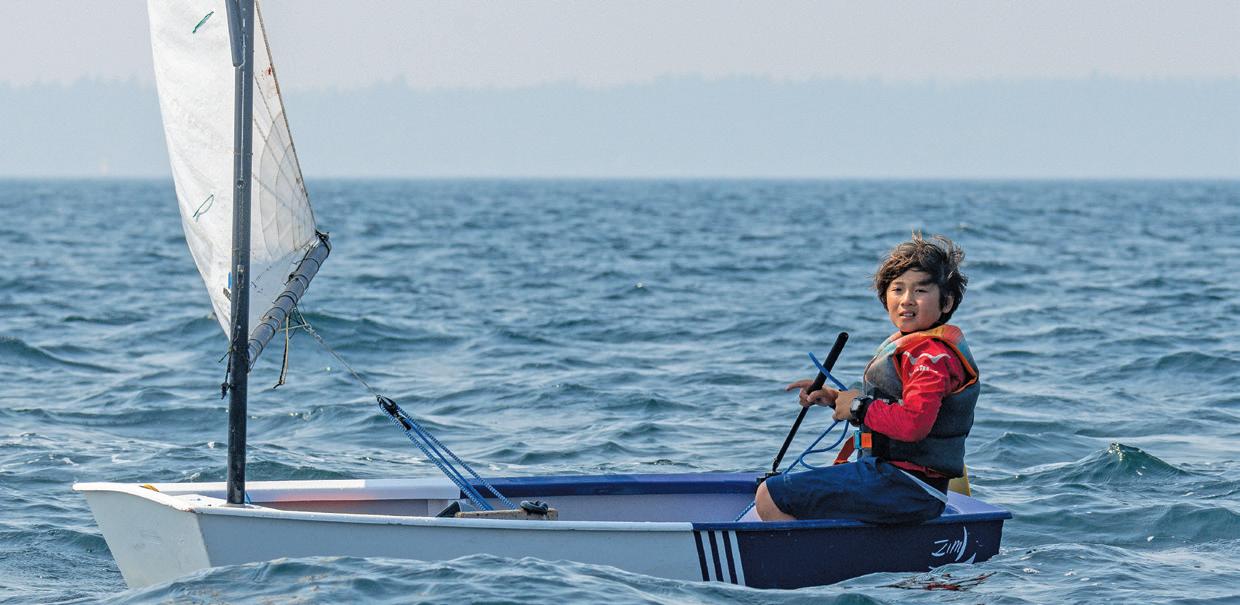 by Solvig Sayre
by Solvig Sayre
Getting your child into sailing leaves a lot of parents overwhelmed and confused. I can commiserate and understand, there are so many choices! Here in the Pacific Northwest, we have a variety of programs that are trying to meet the varied needs of parents and kids.
Recently, I met up with Chris Roberts, an active keelboat racer with a young son who has been getting into sailing, to hear a little about what roadblocks he has faced. Chris has been candid about how puzzling the whole youth sailing scene is to him, and how surprising that is for a parent who is already so deeply involved with sailing. Inspired by our conversation, I worked on some tools that might help prospective parents and grandparents develop more clarity about the various pathways young sailors may explore in our region.
When choosing a sailing program for your sailor, you might start looking at anything from local yacht clubs to community sailing programs, from maritime nonprofits to summer camps. The Sailing Foundation maintains an active list of 50plus learn-to-sail programs in Washington and Oregon at www.nwyouthsailing.org. Consider what you are looking for and how important each of those things are. Location and schedule are the obvious ones. However, another good preliminary question to ask the program is what types of boats they will be sailing in that class or camp. Since each program is so different, you will find less frustration if you stay with a program for an extended period. To get a sense of what the program’s goals
and opportunities are for each child, I would recommend asking what the sailors in the most advanced classes in their program are doing and if there are multiple pathways offered.
Something that might surprise many parents is that programs typically expect children to take the same class multiple times. Each program writes their curriculum a little differently, so it may be helpful to inquire about the anticipated pace of progress before signing up. Then, if your sailor enjoyed the class or camp, ask the director to give a recommendation about the ideal next steps or camps for your child at the end.
Another frustration parents run into is that available space in many programs fills up quickly, which makes it important to reach out to the program to find out how to get notified when sign-ups open. Space is limited for many reasons. Sailing is a complicated sport that has some inherent dangers, and as a result the ratio of sailors-to-coach is much lower compared to sports like soccer or baseball. Many programs also find staffing to be a challenge because of the amount of knowledge required to teach sailing, not to mention the cost of an effective coach boat.
YOUR CHILD’S FIRST DAY
Most programs give great information about what to expect on the first day, make sure to read it. It is common that parents are asked to leave the premises after drop-off, or may be given an area from which to observe. Many programs these days supply almost everything your child needs for learning to sail; a boat, helmet, lifejacket, and wetsuit. I suggest inquiring
48º NORTH 20 APRIL 2024
Photo by John Beaver.

what their requirements are for footwear (this is generally not supplied) and whether there are expectations for families to provide additional required or recommended gear. Not all programs require a helmet and wetsuit, so those might not be supplied.
Be prepared that your child will sail very little in the first two days. The time spent on land is crucial to each child’s success and enjoyment of sailing. The skills learned on shore will give the sailor the confidence to enjoy their time on the water—I believe fun comes from the freedom to sail on your own, and freedom comes from a solid foundation of the basic skills. The time spent learning alongside and about their classmates will also help them create friendships that will keep them coming back, even if they are struggling with a skill on the water. Don’t forget to send your child with dry clothes, a towel, water bottle, and sunscreen for reapplying throughout the day.
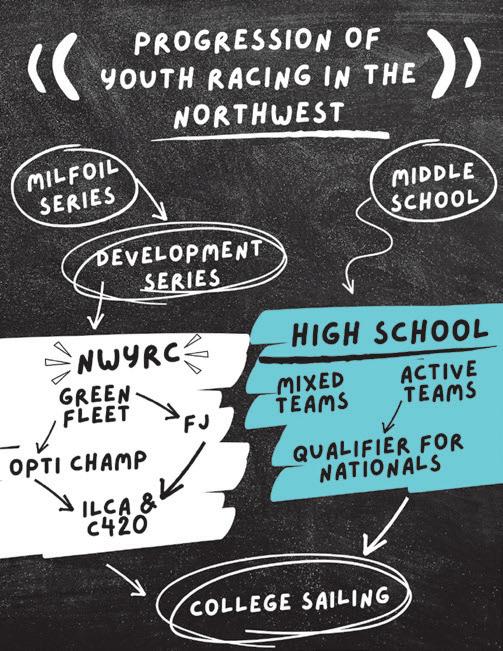
GETTING STARTED IN DINGHY RACING
After your child has been sailing for a few weeks, they might be starting to sail independently upwind and might be interested in trying some racing. If you live in the Seattle area, ask your program about the Milfoil Series. This series of fun-focused halfday regattas provides lots of on-the-water support and offers a casual entry to racing. They are normally in very protected areas but, as sailors, we also know that this environment often
leads to very challenging conditions—current, along with gusty, shifty, and light winds. If you live outside of Seattle, ask your program director if they host any casual races, and please offer to volunteer.
Dinghy racing is so much fun and joining a race team at most programs requires an invitation from the race coach. If you are interested, ask questions and find out how to get involved. Please do not overlook the question of whether there is space on the team, as well as if your child’s sailing skills are developing enough that they’re ready to join the team. Are they a few years off, are they on the bubble, or are they ready? Remember that, in the interest of safety, it’s possible that your skilled and talented sailor might be considered too young to be relied on to be an active listener and follow instructions, which may delay their invitation.
One step beyond the Milfoil Series, there is a Development Series that offers a couple of regattas in the spring and fall. These are smaller events that often have supplied coaching and allow coaching around the race course. It is a great learning opportunity for newer racers.
Green Fleet Optis at Northwest Youth Racing Circuit (NWYRC) are for sailors at a similar level of progression and skill as the Development Series. The Opti “Green Fleet” is a national concept aimed at introducing young Opti sailors to the world of racing, and its major focus is on learning instead of results. Accordingly, coaching is allowed on the race course (at other
48º NORTH 21 APRIL 2024
High school sailors may compete outside the region, like at this regatta at Newport Harbor in California.
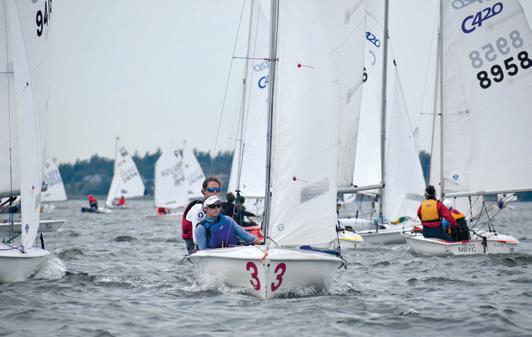
levels of racing, a coach is not allowed to communicate with a sailor who is in a race until they have finished the race, unless there is a safety issue). Even in these learning-oriented entry-level racing environments, it’s important to make sure the program director feels that your sailor is ready. This is not a learn-to-sail opportunity, these sailors need to be able to proficiently sail upwind on their own. The coaching is there for tactics, strategy, and rules more than for foundational skills. Once you graduate from this level of sailing there are lots more opportunities, particularly the NWYRC.
The Northwest Youth Racing Circuit is a series of regattas organized by The Sailing Foundation in partnership with hosting clubs and organizations across Washington and Oregon. There are five regattas with classes for Optis, three rig sizes of ILCAs (previously known as Lasers), and C420s. There is a parallel circuit of two regattas for FJ dinghies only that joins the other fleets at Sail Sand Point for a third and final big regatta in the fall.
NWYRC events are two full days on the water, and sailors will be out all day, even eating lunch on the water in between races. It is strongly advised that programs have a coach in a coach boat at these events. This circuit is only getting bigger and stronger as the enthusiasm is very high and the sailing staff around the region becomes more professional. Cameron Hoard, the Seattle Yacht Club Race Coach, tells me that when he moved to Seattle a decade ago, he was the only professional coach on the water, and there were less than half the number of sailors participating. At that time, people who were on the water were mainly safety
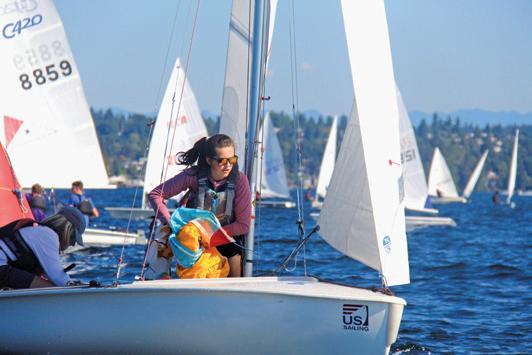
boats and it was much easier to keep track of all the sailors. Now that there are so many participants, a coach on the water can help ensure their sailors are safe, happy, and learning. Coaches help each other keep everyone safe when a squall comes through or another unpredicted safety concern arises. When the conditions are as expected, the coaches focus on their sailors to make sure they are improving. The Northwest Youth Racing Circuit is the region’s pinnacle event series for young sailors, and is an important stepping stone for developing skills to help sailors on the national stage.
SCHOLASTIC SAILING
High school sailing is another popular route to sailing. Many schools take novice sailors who are motivated to be a part of a strong community on the water. Most of these regattas are what we call “A-B rotations”, where four or more sailors make up a team. Two sailors go out and sail two A races in their FJ, then they come to shore and hand off their boat to the second pair on their team who go and race two B races in the same boat. They continue to switch back and forth, and there might be substitutions made. The races are short, around 10-15 minutes long.
Unlike the NWYRC, in high school sailing coaches are not allowed on the water, and any coaching they do happens from shore. These events are organized by Northwest Interscholastic Sailing Association (NWISA), under the national governing body of the Interscholastic Sailing Association (ISSA). There are two types of high school teams, “active” and “mixed” teams. Active teams are those that follow the eligibility requirements of ISSA, where all the sailors are full-time enrolled students at the same high school that is registered with ISSA. Active teams are eligible to compete to qualify for the national championship. Mixed teams are a group of sailors in 8th-12th grade, who might not necessarily go to the same high school. Sailors from mixed teams who want to compete outside of the region in youth sailing should get involved with their local sailing school in another boat like the ILCA 6 and could try to qualify for the ISSA singlehanded national championships, as an individual representing their high school. Check out the NWISA website for more information, especially if you are homeschooling.
The North Sound (San Juan Islands, Bellingham, Anacortes, and Oak Harbor) has started a middle school racing circuit that mirrors many of the principles of high school sailing. They also do A-B rotations, but sail singlehanded RS Tera dinghies. These sailors are getting really good! I can’t wait to see how good their high school teams get over the years.
As you can see, there is so much information to digest. The important thing to remember is that there are options and that, if your child wants to sail, there’s a program to help them do that. It really is an exciting time to be getting involved in youth sailing in the Pacific Northwest!
Solvig Sayre is the Youth Sailing Director at The Sailing Foundation, where she works with programs around the Pacific Northwest. She has extensive experience on the US Sailing Team and leading youth programs around the country. Check www.nwyouthsailing.org
48º NORTH 22 APRIL 2024
Setting the kite at the Octoberfest Regatta, which combines the NWYRC and the FJ series. Photo by Nathan Koliha.
Lots of boats on the water during the Bellingham Youth Regatta. Photo by Maddy Lindburg.
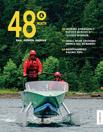

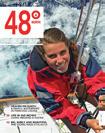
PREMIUM 48° NORTH SUBSCRIPTION
Become
addition to your magazine each month, with this exciting new subscription offering, you’ll also be supporting 48° North in a more meaningful way. But, warmed cockles are far from the only benefit. Others include:
• Discounts at Fisheries Supply Co.
• One free three-day to the Port Townsend Wooden Boat Festival ($40 value)
• 10% off of Northwest Maritime Center classes, excluding Sailing Club
• Discounts on registration fees for events
• Cool bumper sticker and decals.
• $75/year (additional fees for First Class forwarding or International)
JUST THE MAGAZINE, PLEASE:
Our standard subscription gets you 12 months of 48° North and its associated special publications (SARC, Setting Sail, and the Official R2AK Program).
• $39/year (additional fees for First Class forwarding or International)





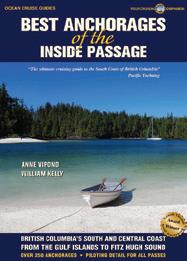


48º NORTH 23 APRIL 2024 email: info@oceancruiseguides.com www.oceancruiseguides.com Best Anchorages of the Inside Passage 2nd Edition: $44.95 – 336 pages Available at leading bookstores and chandleries, and online Find your Dream Anchorage Over 250 anchorages with anchoring tips & waypoints Hundreds of maps and color photographs Piloting detail for more than 30 passes Includes dozens of ports and marinas Explore the B.C. coast with the new edition of Best Anchorages of the Inside Passage TODAY!
a part of the 48° North crew!
In
Subscribe today online: 48north.com/subscribe
Quality Swaging - Wire & Rod Rigging Refurbishing or Custom Masts - Spreaders
Rigging - Pole Controls - Lifelines - Electrical Reefing set-ups - Carbon poles 25 yrs. preparing clients for Coastal & Offshore Cruising 360-385-6330 www.PortTownsendRigging.com Quality Swaging - Wire & Rod Rigging Refurbishing or Custom Masts - Spreaders Running Rigging - Pole Controls - Lifelines - Electrical Reefing set-ups - Carbon poles 25 yrs. preparing clients for Coastal & Offshore Cruising 360-385-6330 www.PortTownsendRigging.com
SUBSCRIBE
Running

DIESEL DEEP DIVE 24 SAILDRIVE OR DIRECT DRIVE?
by Meredith Anderson
Shopping for a new sailboat or considering changing the current setup onboard your own boat to provide extra space behind the engine?
Since the dawn of inboard engines aboard vessels, sailboats have been equipped with direct drive propulsion and it has proven to be a success in design and function over the years. But nowadays, almost a third of new boats are being built with a saildrive. So, what’s the big deal? Are they something to run away from? Are they better than the tried-and-true direct drive system most of us know well? What are the pros and cons of each, and which would you want to have on your boat? I will cover some of the basic concepts of both methods of propulsion below from the perspective of a diesel mechanic, including the pros and cons of each.
DIRECT DRIVE
Let’s start with the conventional concept of “direct drive” as our system of propulsion. Direct drive propulsion involves a straight propeller shaft that’s bolted onto the engine’s reverse gear, exiting through the bottom of the boat via a shaft seal such as a PSS dripless seal or a standard packing gland, going through a
cutlass bearing (or support bearing within the strut essentially) before having a propeller of pretty much any style bolted onto the end of the shaft. Early propeller shafts on much older boats (60-100 years old) were often constructed of Monel—a very strong and corrosion-resistant mix of metals including nickel and copper along with small amounts of several other metals—which performed well, but were insanely heavy! Then came bronze shafts that were very corrosion resistant, but rather soft. Finally, stainless steel was used because it is stronger than bronze, but not quite as corrosion resistant when it comes to oxygen depletion. Stainless is what most direct drive shafts are made of today.
Direct drive setups are straight forward to service and just about any boatyard knows what to do with maintaining this portion of your propulsion system. Shaft anodes are typically easy to find at chandleries and marine stores, components throughout the system are relatively affordable to replace—including the shaft if it’s bent or damaged—and best of all, there’s no gaping hole in the bottom of the boat. The only consumable components to maintain or replace, such as the cutlass bearing, prop, or shaft seal, are actually built to last a fairly long time. Much of this setup typically sees failure only in the event of neglect, hitting
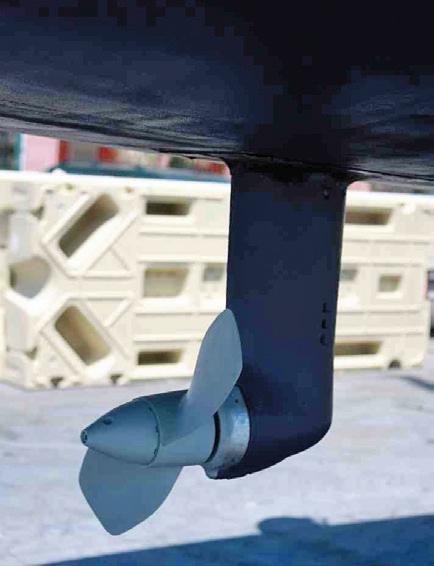
something, or improper installation. Direct drives are simple, reliable, low-key setups that shouldn’t require too much upkeep if properly maintained.
One compromise on boats with a direct drive system is that the propeller shaft goes through the bottom of the boat at a slight angle (15 degrees or less) meaning that space behind the engine isn’t really usable for storage or living space. Depending on the boat, its intended use, and the sailor using it, this may be a significant reduction in utility. A lot of older boats typically have the engine mounted as far aft as possible, sometimes with significant dead space behind the engine as a result thanks to an exposed spinning propeller shaft. If the engine is mounted farther forward in the boat, then some sort of tunnel or open space (known as a shaft alley on bigger vessels) has to be made for the prop shaft as it exits the bottom of the boat, making the space undesirable to store anything, or to use for living space.
According to some folks, direct drives can be more prone to vibration as well; however, if properly installed, aligned and maintained, I don’t necessarily agree with this. Indeed, alignment of a direct drive setup is critical for longevity of its components, the reverse gear, oil seals, and other parts to avoid significant vibration and even damage. Unfortunately,
48º NORTH 24 APRIL 2024
it is possible to repair or install a direct drive system adequately in most facets, but to not understand or attend to the crucial importance of extremely accurate alignment, which can lead to more issues for the boat owner down the road.
SAILDRIVES
All that direct drive stuff sounds pretty good, doesn’t it? So, why are some vessel manufacturers moving away from direct drives as their standard setup? The biggest reason is living and storage space. Saildrives are a rather neat innovation for the “space” problem aboard sailboats where space is at a premium. Saildrives remind me of inboard/outboard engines found on some small power boats, where the inboard diesel sits comfortably underneath your companionway stairs or inside a usually tiny cabinet. The reverse gear that is bolted to the back of the engine actually exits the hull directly below through a large rubber diaphragm bellows into the water where a lower unit that looks like an outboard’s lower unit is attached. The lower unit is a sleek shape, just like an outboard would have, and is built out of lightweight aluminum that reduces drag and the need for super precise alignment of multiple parts.
Saildrives are only built for engines that are 80 hp or less, so you typically only find them on sailboats. Volvo Penta and Yanmar are the two most common saildrive manufacturers I come across, and they are designed to give the owner as much space as possible inside the boat. Their lightweight nature and sleek design make them desirable to many racers I know where drag is reduced and with the right propeller. Additionally,
they are fairly quiet compared to the classic direct drive. Most of the vessels that I have worked on do, in fact, make great use of the extra usable storage or living space with amenities such as a full size bed in the aft cabin directly behind the engine, but this comes with its own compromises.
While comfort and space is a nice plus for the interior of a sailboat, the cost-benefit balance can be quite challenging. Early saildrive owners had the understandable fear of the bellows leaking or tearing; however, this was quickly shown to be extremely rare for something that catastrophic to happen, and the design of the “through-hull” bellows has been improved since those first sail drives appeared on the market.
One primary compromise is that saildrives require more, and more frequent, maintenance. Many stipulate hauling the boat out of the water to change the oil once a year. Volvo actually has released a new saildrive where this process doesn’t necessitate hauling the boat, but a majority of saildrive lowerunit oil changes are still done out of the water.
Another common complaint often relates to sacrificing engine compartment space. Space may be so limited that a comparatively simple repair like replacing a heat exchanger, manifold, or some other part could require pulling the engine out of its compartment. This is unusual, time consuming, and costly.
An even bigger issue is how susceptible to galvanic corrosion the saildrive’s lower unit is, since the housing is built out of aluminum. As we know, aluminum is a sacrificial anode in every body of

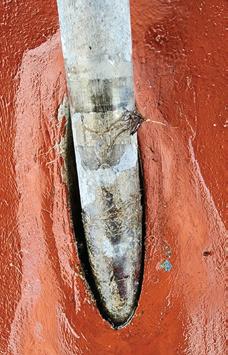
water—fresh, brackish, or salt. Staying on top of your anode replacements is, thus, critical to protect the unit. If you want to add a folding prop or extra through-hulls to your saildrive system, increasing the size of the anode surface area is super important. The saildrive’s original factory-equipped anode will be designed for a standard prop/throughhull setup. Changes to your setup may well require changes to the anode. A seemingly minor scratch in the paint on the lower unit can be catastrophic if not cleaned up properly and repainted right away. Installing a galvanic isolator is also a good idea to protect your lower unit from the boats around you. Having serviced lower units personally, I can’t tell you how many I had to replace due to severe corrosion; and the owners didn’t even know anything was wrong.
Like all elements of boat design, there are compromises with both direct drives and saildrives, and each of these technologies have their fair share of quirks and problems. However, both are reliable and functional if well maintained by a diligent boat owner. Saildrives require more diligence and money in terms of regular upkeep, are not very forgiving to inattentive maintenance; but they offer a smoother, quieter ride as well as more interior space. A direct drive system is tried and true in terms of how it works and who can service it when it does need repair. Usually, a conventional direct drive setup won’t require that work be completed by a shop designated by the manufacturer, which might appeal to cruisers headed to remote locations.
The choice between these attributes won’t necessarily be the deciding factor for any person buying a boat or trying to understand the one they already own more deeply. Still, in the complex world of boat systems, these considerations are worth examining closely and should inform your expectations for future maintenance and ownership. Which one would you choose?
Meredith Anderson is the owner of Meredith’s Marine Services, where she operates a mobile mechanic service and teaches hands-on marine diesel classes to groups and in private classes aboard clients' own vessels.
48º NORTH 25 APRIL 2024
Neither system is perfect: saildrives (left) can be particularly susceptible to galvanic corrosion, while a direct drive (right) can inflict and sustain damage when not properly aligned.
SHORT HOPS BETWEEN SOUTH SOUND WALKS
by Michael Boyd

Ah, the dawn of the high cruising season around the Salish Sea. It’s always an exciting time to make plans for where you’ll travel and what you might explore when you get there, and also a great chance to start getting out there! For us, finding and enjoying lovely boat-accessed hikes sits near the top on the list of priorities, and our experiences with that pursuit are what this column seeks to illuminate.
Before pointing the bow farther afield when you’ve got maximum daylight and more consistently pleasant weather, many cruisers take advantage of springtime to embark on a few shorter trips in local waters to bust off any winter rust and discover—anew or again—the innumerable close-to-home gems the Pacific Northwest has to offer. For those around Puget Sound, the southern reaches of this exquisite waterway can deliver some unexpected wonders by boat and by foot.
HOPE ISLAND STATE PARK
While lovely and generally quiet, the shoreline of the South Sound is mostly private land, which limits access; but there are more hiking opportunities than you might think. About 8 miles north of Olympia is Hope Island State Park. Like many island state parks, there are facilities both on and off shore. There are mooring buoys on the south and west sides that we usually take, if available. The alternative is anchoring, but the island sits at the confluence of Totten Inlet, Squaxin Passage, and Hammersley Inlet and significant tidal currents can make setting your hook a bit tricky, especially during spring tides. We have anchored on the east side and found it to be rocky
in places; it took several tries to find a place where we could get a good set on our anchor. The west side provides secure anchorage, though it might be a bit deep for some boaters. The south side has the largest anchoring area but is most subject to wakes from passing vessels. We feel secure there, but not comfortable enough to spend the night during prime boating season. Sometimes we just stay for the hike.
Hope Island has a mostly level, well maintained trail going completely around its perimeter, typical of many state park trails. The trail can be accessed from the water in two places, via a set of stairs on the west side of the island or from the campground on the south end. We’ve never found it crowded.

48º NORTH 26 APRIL 2024
26
HIKES FOR BOATERS
Photos by Karen Johnson
Hope Island west side trailhead from the trail.

We particularly enjoy coming to Hope Island after visiting Olympia; trading urban hiking for a peaceful trail through the woods.
JARRELL COVE STATE PARK
Jarrell Cove State Park is only 8 miles northeast of Hope Island, though this direct route is for small boats only as it passes under a fixed bridge with a 31-foot clearance. Sailboats need to take a much longer route to get there. This cove is one of the most popular destinations in the South Sound for good reason. It is almost landlocked and the protection is near perfect. There are plenty of mooring buoys and a new state park mooring float that even has electricity available, a rarity for state parks. Yet with all of that, there is still some room to anchor.
We like the hike through the park lands but find it a bit too short; just as we are getting into the rhythm of the hike, it ends. There is a longer hike to Harstine Island State Park and its trail network but it requires significant road walking to get there. Still, either might be just right for you! Compensating for the limited hiking is interesting exploration of several small streams and inlets via kayak or dinghy.
ANDERSON ISLAND
To the southeast, Anderson Island is located about 10 miles south of the Tacoma Narrows Bridge. At its southeast corner is Oro Bay, which actually consists of two bays, an outer bay with easy access but more exposure to southeast winds and

Nisqually Reach wakes, and an inner bay with a somewhat complex entrance but more protection. Friends tell us the cell phone coverage and view of Mt. Rainier is better in the outer bay but we have always headed for the inner bay where the derelict Ocean City ferry is slowly rotting away. Whichever you decide, the anchoring is good and there are rarely more than a couple of other boats.
We find the hiking here to be the best in the South Sound. It’s not one park but three that are separated from each other by short road walks. You can hike one, two, or all three. The first is Jacob’s Point Park on a peninsula jutting into Oro Bay. Access to the well maintained trail is from a set of stairs ending in the outer bay, just east of the buoy marking the entrance turn into the inner bay. From here you can walk a circular loop around the Jacob’s Point peninsula, mostly in trees, with many views out to the water. Or you can continue via a short road walk north (turn right) to the next park, Andy’s Wildlife Park.
The Andy’s Wildlife Trail is a circular loop through a mixture of terrains, from wetlands to meadow to forest with some modest elevation gain. At a wet time of year, waterproof boots may be required, but we’ve only done it in late summer and fall when the trail has been merely damp in places. At about the midpoint of the loop, a short spur leads to another road and a short walk north (another right turn) to the third park, Andrew Anderson’s Marine Park.
The Marine Park trail heads west to the shore of Anderson Island. There are several interesting loops that can be followed

48º NORTH 27 APRIL 2024
Beach walk on the south shore of Hope Island.
Jarrell Cove trail with steps and picnic table.
Jarrell Cove public float.
OTHER SOUTH SOUND BOATACCESSED HIKES
MCMICKEN ISLAND MARINE STATE PARK
This is a small day-use-only island park with 1,661 feet of beautiful South Puget Sound saltwater shoreline. It is only reachable by boat, except during low tide when you can walk across a tombolo to and from Harstine Island for a few hours each day. Moorage is available around the island with five buoys available and anchoring is easy.
TOLMIE ISLAND STATE PARK FOUR
CEDARS TRAIL
Located on the mainland southwest of Anderson Island, this park has a 1.98 mile loop trail where you’ll pass through coastal forest as well as shoreline and creeks. Starting from the end of the paved parking area, interpretive signs inform hikers about native animals and the role wetlands play in creating healthy habitats. Boaters can anchor just off the park and land dinghies or kayaks on the beach.
FRYE COVE COUNTY PARK
Located on the west shore of Eld Inlet, north of Flapjack Point on Steamboat Island, this park has a 1.25 mile loop trail, with other trails branching off of it. The route has rolling hills that drop down repeatedly to sea level near the water then heading back up through the forest. The trail is mostly forested with views of Frye Cove along the south and east portions.
PENROSE POINT STATE PARK
With mooring buoys and anchoring aplenty, this is a favorite for many boaters who venture to the South Sound. There are two miles of saltwater shoreline and two main trails. The Boundary Trail is a 2-mile loop that offers scenic views of the park and its surroundings, including Puget Sound. The Penrose Point Loop Trail is a moderate difficulty level hike spanning about 3 miles around the peninsula with stunning water views on both sides.

including one through a stand of old growth timber. Eventually you end up on a beautiful pebble beach with driftwood and views out to the southwest over Nisqually Reach. One time, we were there eating our lunch when a large native canoe pulled up to the beach and all the paddlers piled out for their own lunch break. The total round trip hike from Oro Bay to the beach is about 7 miles and, while it has ups and downs, the total elevation gain is only 200 feet or so.
A cushy forest trail, not too long, not too strenuous, with good views along the way and a rewarding half-way lunch spot are qualities that make for a wonderful trail for the adventurous boater. We search for trails like these wherever we go. There are many other places to explore and hikes to be done in this area. These are just some of our favorites. For additional hiking information check out: Afloat and Afoot in South Puget Sound by Marge & Ted Mueller. It’s old but still useful.
Michael and Karen have been cruising the Salish Sea and beyond for more than 20 years, hiking every chance they get. For more resources for hikers visit their website at https://mvmischief.com/library/

Hope Island
48º NORTH 28 APRIL 2024
TACOMA NARROWS
Oro Bay
Jarrell Cove
Trail leading to marine park beach with paddlers.
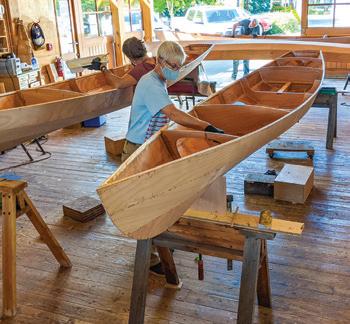


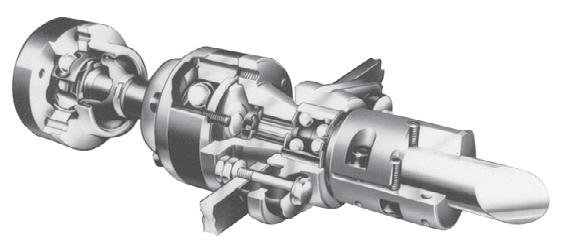
The AquaDrive system solves a problem nearly a century old; the fact that marine engines are installed on soft engine mounts and attached almost rigidly to the propeller shaft.


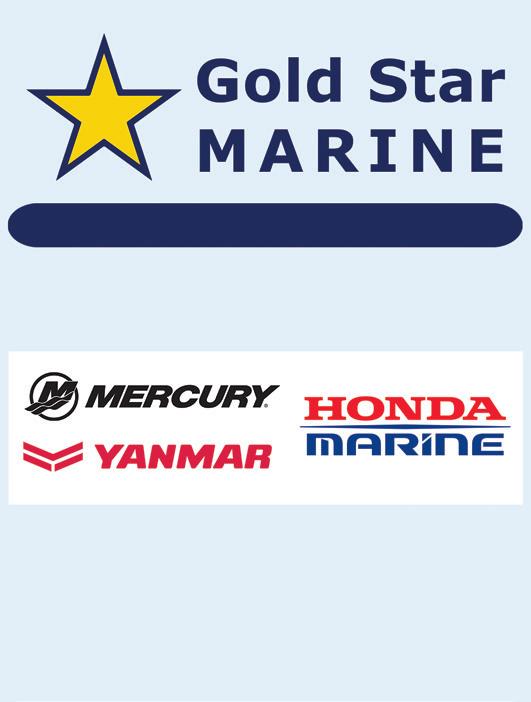

48º NORTH 29 APRIL 2024 INSTALL Business or Pleasure, AquaDrive will make your
boat smoother, quieter and vibration free.
on soft mounts needs total freedom of movement from its propshaft if noise and vibration are not to be transmitted to the hull. The AquaDrive provides just this freedom of movement. Tests proved that the AquaDrive with its softer engine mountings can reduce vibration by 95% and structure borne noise by 50% or more. For information, call Drivelines NW today. 311 S. Brandon St, Seattle, WA 98108 • (206) 622-8760 Visit Our Web Site: www.aquadrive.net 5hp – 2000hp Ships FREE Ground UPS!
Legend for Over
CREATE. CRAFT. LEARN. Boatbuilding & woodworking classes for all skill levels at the Northwest Maritime Center. Learn more at nwmaritime.org 431 Water Street, Port Townsend, WA 360.385.3628 | info@nwmaritime.org
The very logic of AquaDrive is inescapable. An engine that is vibrating
“A‑Northwest
25 Years”

MY BOAT: DIDI 23 KORU
In our latest My Boat column, we’d like to introduce you to Casey Wilkinson and his sweet looking Didi 23, Koru . After searching for several years for a sailboat that he could use with his family, Casey decided to build the boat by himself from a set of plans, starting in May of 2020 and launching in October of 2022. He wanted something that had enough room to sleep four, had a separate enclosed head, decent headroom, and could be trailered and launched easily. With its raising keel, the Didi 23 design ticked those boxes beautifully, and can fit on a low trailer and be launched at almost any ramp. Koru is homeported on Bainbridge Island, Washington, where Casey operates a small boat building outfit called Kea Custom Boats.
Tell us about your boat’s name.
Koru is a word from the New Zealand Maori language. It is the word for the new shoots of the New Zealand Silver Fern. It also has deeper meanings related to re-birth, new beginnings, growth, and strength. This is the first keelboat I have built for my family, and this name came to mind thinking of all the new adventures we would have on her.
Tell us a little about your boating background. Have you owned other boats before this one?
I have a long background with boats. Being a former marine biologist and dive instructor, I have experience on everything from 10-foot skiffs to 225foot research vessels. Now, I run my own small boat building company, and between personal and professional projects, I have built more than 50 boats including kayaks, 15-foot powerboats, sailing dinghies, rowboats, and my Didi 23. Most of my sailing experience has been in smaller dinghy-sized boats between 10 and 15 feet long.
Who designed the Didi 23?
The Didi 23 was designed by Dudley Dix. It is based on the Didi 26, which is one of Dudley’s most popular designs. The 23 has almost the same lines as the 26, but the bow area is 3 feet shorter and there’s a smaller keel bulb. I built it for my own use, and as a display for my company.
APRIL 2024

The boat is built from 9 mm okoume marine grade plywood that has been fiberglassed on the outside and epoxy sealed on the inside. Stringers are made from Alaskan yellow cedar, and hardwood accents and the keel foil are made from Sapele. The cabin and cockpit sole are made from teak and holly marine plywood. She weighs (on the trailer) about 2,500 pounds. The keel is a foil shape with an 850 pound lead bulb on the bottom. Her draft is about 18 inches with the keel raised and 5-feet7-inches with the keel down. The keel is raised using a synthetic line reeved through a custom-built pulley system to one of the cabin top winches. The top of the keel comes out through the cabin top and the bulb sits up against the bottom of the hull.
I decided to add a sugar scoop transom, which extended the LOA to 24-feet-8-inches. The waterline was also lengthened to about 23.5 feet. The sugar scoop is a great place to board the boat from the dock, and even better from the water if anyone were to go for a swim. I

decided to mount the rudder on a shaft instead of using gudgeons and pintles, so I did not have to cut a large V out of the bottom of the scoop. The rudder is

a balanced spade style and the shaft goes up through custom carbon tubes to the tiller head. The entire assembly is mounted on the transom using a piano hinge. This allows the entire rudder (with


a small section of the scoop) to swivel up for trailering.
I don’t like the aesthetic of an outboard hanging off the back of a small sailboat, and wanted to keep things quiet, so I opted to install a 1kw electric pod drive by ePropulsion. I decided to make the motor retractable to lessen drag when sailing, and to keep it out of the water when moored at my marina.
Describe your personal experience of the build process?
The building process was extremely rewarding and, overall, it took me about 2,000 hours over 2 years and 4 months. I have built many boats, but never one this large. The biggest learning curve for me was in designing and installing systems. I spent a good two weeks talking about how I was going to store fresh water, much to my family’s dismay, and I ended up settling on portable plastic carriers. The most fun was learning how to create a full electrical system from the ground up, setting up the running rigging, and completing all

48º NORTH 31 APRIL 2024
Planks of 9 mm plywood have been installed. The rounded chine, formed from 2 layers, is next.
Koru has been flipped and work on the interior is about to start.
View of the interior, note the Alaskan yellow cedar stringers.
Koru has a clean and functional nav station. Looking forward through the cabin from the port quarter berth.

the canvas work (though I didn’t make the sails). The hardest parts were figuring out how to flip the hull, getting the boat on the trailer, and devising a system for stepping the mast.
Another challenging part was sourcing all the hardware. I spent many evenings trying to find just the right hinge or through-hull fitting, only to realize that it was the wrong size or I forgot to purchase fasteners for it. Moreover, I learned that any little change I made— such as changing the shape of the companionway—led to several hours worth of work figuring out the cascade of changes that followed.
The most rewarding part, by far, is sailing at 6.5 knots on a beam reach knowing that I built this boat myself!
How did this build process compare to other builds you’ve completed?

Since I have built quite a lot of wooden boats using a variety of techniques, the process for this one was similar to many previous builds, with a new twist. The hull for Dudley Dix’s Didi series is built using a technique called “radius chine.” This involves using marine plywood (9mm in my case) to create the flat areas of the hull sides and V bottom. The rounded chine is then made from two layers of 4mm ply. The deck is then created with a traditional stitch and glue method. The entire boat is covered in fiberglass with some sections of unidirectional carbon fiber for strength.
What do you like best about your boat?
I love the racy lines and incredible performance, yet how comfortable it is inside. The fastest I have had her up to so far has been 7.2 knots (above hull speed) on a broad reach under the reefed main

alone. There is another Didi 23 in Hood River, Oregon that reportedly has hit 15 knots using an asymmetrical spinnaker. The cabin has a very roomy double berth up forward and two extra long quarter berths under the cockpit.
What do you know now about your boat that you wish you’d known when you built it? Would that have changed your mind?
I wish I had known that the pandemic would drastically increase the cost of all the supplies, especially stainless and silicon bronze fasteners.
What’s your favorite story involving your boat?
My wife and I were out for an afternoon sail when another sailboat came close to ask us questions about Koru. We stayed close for a few minutes then headed back

Launching the boat in Kingston after two years and many hours were put into the build process.
48º NORTH 32 APRIL 2024
The V-berth converts from a comfortable bunk to a table that can raised and lowered.
Koru has a pair of extralong quarter berths.
Koru’s owner and builder motors out of Eagle Harbor.
to our respective docks. The two men on the other boat then came and found us as we were buttoning up our boat. We talked for about 20 minutes and they were very complimentary about our boat. After they walked away, my wife looked at me and said, “You know who that was, right? That was Jay Inslee!”
Describe the most challenging situation you’ve experienced on your boat and how it performed.
The most challenging situation I experienced was when I moved the boat from the ramp in Kingston to my slip on Bainbridge. There wasn’t a breath of wind and I hadn’t really tested the motor yet, since this was the first time going farther than a half a mile beyond the ramp. We were motoring very slowly for about 45 minutes and then stopped to let a superpod of 0rcas go by (a super-pod is when members of all three Southern Resident Killer Whale families are spotted together). After they moved along, we were running out of time before sunset so I sped up to full throttle. The battery emptied after about a minute. I had drained the single 1-kw-hour battery too far. I carry a generator, but it was taking too long to recharge the battery, so I had to get towed into Bainbridge. I now carry a spare battery so I can charge one while

using the other during long passages with no wind.
Where do you plan to take your boat? Do you have a dream destination?
I would love to take Koru up the Inside Passage and all over the Salish Sea.
If someone gave you $10,000 that you could only spend on your boat, what would you do with it and why?
I would buy enough battery capacity to allow me to motor at full throttle for at
least 5 hours, and I would also buy a new Code 0 for better light air performance.
If you could have any other boat, what would it be and why?
I would love to have a boat large enough to live on and cruise to far flung places like the South Pacific.
Want to share the story of your boat in a future column?
Contact andy@48north.com.



48º NORTH 33 APRIL 2024
Nova’s Destination
Northwest Passage... What is Yours? Terra Nova’s Destination was the Northwest Passage... What is Yours? PortTownsendSails HasseandCompany 919HainesPlace PT,WA98368360.385.1640contact@ptsails.com Port Townsend Sails Hasse and Company 919 Haines Place PT, WA 98368 contact@ptsails.com 360.385.1640
Terra
was the
One of the owner’s touches was to craft a well for the retracable electric motor.
by Joe Cline

SEA ADVENTURER
AN INTERVIEW WITH KIRSTEN NEUSCHÄFER, PART 1
South African sailor and adventurer, Kirsten Neuschäfer earned worldwide acclaim for winning the “retro” Golden Globe Race around the world in 2023. She recently visited the Pacific Northwest, and gave a sold-out presentation in Port Townsend, where her boat was built. In this first portion of a two-part interview, 48° North Managing Editor Joe Cline and two-time R2AK-winning skipper, Jeanne Goussev, sat down with Kirsten to gain some insight into the sailor whose 235-day nonstop circumnavigation wowed the sailing world; but whose competence, temperament, and commitment to adventure make her accomplishment seem remarkably reasonable.
Joe Cline: You had a childhood dream of learning to sail. Would you elaborate on that?
Kirsten: I grew up inland, so I didn’t have that much access to water, but I loved water. On the odd occasion that I’d get to go sail on a dam because my parents had friends who had optimists or dabchicks, I knew I loved it. I also loved going down to the sea, and I loved traveling and exploring. Between that and reading stories about sailing and great explorers like Shackleton, I had this dream that it could be a cool thing to do someday.
What do you remember about your first experiences on those small singlehanded dinghies?
One very vivid memory is going out when we should not have been out. It was blowing 40 knots. I went out with my father and the whole bow was plowing into the waves. I remember just thinking, “This is the most amazing thing ever.” I could easily spend all day either in the water or on the water. It was just that feeling of moving with wind, of having fun. What’s cool about those boats is that you can send kids out without too much happening. As a kid you think, “Wow, this is up to me now, to figure it out, to get it moving.”
From those early experiences onward, what led you to want to do something like the Golden Globe Race?
It would pretty much be my whole sailing career (laughing). There was never a goal in my mind. I’ve always just been open to going and getting a job, enjoying it, going somewhere else, and finding a new challenge.
Looking back on it, everything I did in my later adult life in sailing was somehow part of the prep. I worked as a sailing instructor, delivery skipper, and as a charter skipper. All of those things, in their own way, contributed towards the experience to have the confidence to embark on the Golden Globe Race.
But what led me to it exactly, I can’t say, other than the inception of it in 2018 when it came back on the circuit. That’s what attracted my interest in it.
Jeanne Goussev: What was the big draw of the Golden Globe Race? Being on the water? Your relationship to the ocean? The boat?
It was a combination of everything. I love my job as a skipper, I love being on the water. I love sailing, the sport of it. I love that sailing is an adventurous thing, it’s a means of transport as well. For me, I had not been a racing sailor, I had been more of an exploratory sailor. So, one of the biggest draws was the
48º NORTH 34 APRIL 2024
challenge of it—after all the sailing I’ve done in my life, am I up for what seemed like the ultimate sailing challenge?
Jeanne: Is it finding your boundary? Seeing if you have a limit?
I think it’s pushing the limit. Or not even pushing the limit so much as pushing yourself to greater potential. I set a challenge because when I get too comfortable in a job, I want to do something new. A challenge like that is going to make you learn new things, new skills.
Joe: Speaking of those skills, on a race that allowed only late60s technology—smaller boats, no GPS, no modern amenities like autopilots or sophisticated weather information—how much did your career prepare you for these more traditional skills of navigation and self-sufficiency?
A lot of my work entailed having an Ocean Master ticket, so you needed to have at least done a course in celestial navigation. But I’d never used it, so I did practice it before the race far more intensely than I would otherwise ever have done. That was another draw of this race, you’d be obliged to do it.
For the celestial, it was really a matter of ‘figure it out.’ I didn’t have anyone teach me. I had to just get out there and do it. However, a few of the old school sailors did tell me not to worry too much about it. Little words of encouragement that it’s actually not as complicated as it appears to be in the beginning were helpful.
I had spent a lot of time in the Southern Ocean, so I felt very comfortable with the idea of the weather patterns you will experience sailing down there. I felt very comfortable with selfsufficiency because of the work I had done where you needed to have stocked your boat properly and been pretty competent about fixing things.
way around the world without having an electronic device. It’s a really rewarding skill. It’s a good exercise in discipline, as well, and forces you to be more observant about what’s happening around you, rather than just having it all fed to you by way of the screen.
Your chosen boat for the race was a Cape George 36 that sailors here in the Pacific Northwest will be familiar with. How and why did you choose that as your vessel for the Golden Globe Race?
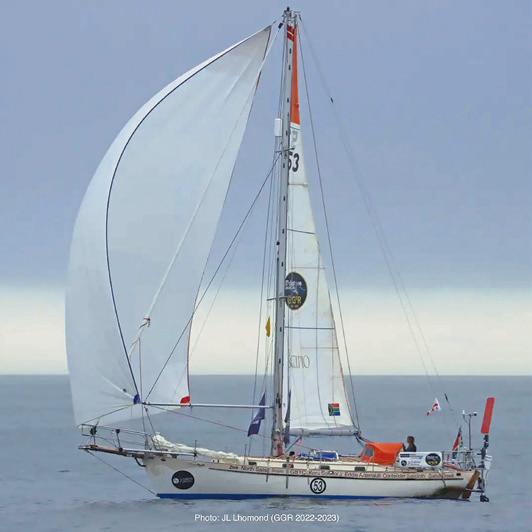
When I signed up, I really wanted to give it my absolute best to try and win the race. So, when I was choosing a boat, I did a lot of research and looked at various permitted designs and tried to figure out which boat I believed could be fast but could also be really, really strong. When the Cape George popped up on my radar, it seemed like I could have both those qualities. It could potentially be fast, although not everyone agreed with me on that point, because they said it’s a really heavy boat. But I like the idea of a heavy boat because when I was working down south and going to Antarctica, we did it on heavy boats. I knew the kind of seas you could encounter down there, and would be happy to be on quite a heavy boat in the Southern Ocean. And I just liked the idea of it being a different boat to any of the boats that people previously thought of for the Golden Globe Race. It seemed like people were fixated on the Rustler 36, thinking that would be the only boat that could competitively sail in that race. I like doing things my own way (laughing).
Other than it being heavy and capable, what attributes of the boat’s design made you think it would be fast?
I did learn new skills doing a really big refit that involved jobs I'd never done before, like major fiberglass work. Those weren’t necessarily things I knew I was going to have to learn, they were just the surprises along the way.
Having won the race, how do you think about the value of traditional skills in the modern cruising and sailing worlds?
We’ve got information at our fingertips all the time about weather and our position, whether it’s on land or at sea. A lot of people, including myself, can’t navigate through a city anymore without using Google Maps. So I think there’s actually a lot of value in trying to move away from it. Not cutting out the modern stuff, but it’s valuable to also feel like you can find your own
Well, it was the longest on the waterline of all the boats in the fleet, which obviously makes it fast. And it also carries a lot of sail. It’s got a very tall mast and a very long boom, so the sail area can make up for the heavy displacement. What I really loved about it was that it has a really long bowsprit, which just seemed really cool for flying Code Zeros and spinnakers.
You mentioned your refit. What did that involve?
We stripped all the teak off the deck for one, because it looked like some of the bungs had popped out and there might have been leaks. We also did this to access the bulwarks, and we pulled those because they were rotten. Those were two really big jobs. We also put on external chainplates—really strong external chainplates with massive backing plates on the inside—to make the rig stronger. We changed it from having one backstay to having a double-backstay, again keeping in
48º NORTH 35 APRIL 2024
Minnehaha, Kirsten's Cape George 36.

mind what will happen if the boat gets capsized.
We replaced the whole rig. I got Minnehaha with the original wooden rig, and we put an aluminum mast and spars on with new standing rigging and some new running rigging.
I redid a lot of the electronics, rerunning cables and redoing the terminals. We redid a bit of old plumbing. Then there were basic other things—putting on a liferaft bracket, repairs here and there, and certain things you had to do because the race required it, like putting in a watertight bulkhead. In all, it was one solid year of building and improving and fixing.
Jeanne: I loved your mast steps all the way up the mast. Were there other modifications because you were singlehanding?
Yeah, super useful when you’re on your own and you want to get up there quickly. One thing is that we didn’t want a kicker or a vang. We put in a permanent jibe preventer that also doubled as a kicker. That ran to the cockpit, so you never had to go rig a jibe preventer. It was just a matter of if you were going to put on the port or the starboard one. Little things like that made it easier, but otherwise it was standard slab reefing at the mast, and a lot of going to the deck for hoisting spinnakers or whatever.
Joe: When you were finally sailing Minnehaha, what were your first impressions?
Well, my first sail was a pretty rough one. It was out in the northern Atlantic in winter, so my first sail was in 50-plus knots. I remember being anxious going out in those conditions, and being pretty impressed with how well the boat handled it and what speeds she got. My first passage was from Canada to Cape Town, and I got into Cape Town much quicker than I expected. All around, I was just impressed with the boat.
Tell us about your sail inventory for the race?
If you had one mast, you were allowed 10 sails. If you had two, you could have 12. I was in the one-mast category. I had my three working sails, of course—the mainsail, staysail, and working jib. My working jib was quite special, it was a twin working jib. So it was on one roller furler system, but it was basically symmetrical wings, so you could haul them out in two directions. There were two 4oz sails, so if you were not using
it poled out, you’d have one against the other like one sail with two sheets. And then I had a single sail as well, in case I didn’t want to use the double sail. This was a fortunate thing because I eventually broke one of my spinnaker poles and had to switch over to the single sail. In addition, I had a Code Zero, an asymmetrical spinnaker, a symmetrical spinnaker, a storm jib, and a trysail.
The double jib is interesting, did it have a single bolt rope?
Yes, from what I heard, separate bolt ropes pulling different directions can damage the foil. So with a single, you’d furl it simultaneously from the cockpit, which made it quite a nice rig to have in the Southern Ocean.
But the idea really came from the race rules, which said that you had to have two spinnaker poles—then you could use them to rig a jury rig if you lost your mast. Another rule was that if you had two sails that were stitched together, they’d count as one sail. When I was discussing it with the sailmaker in Cape Town, he was reading the rules and said, if you’ve got two poles, wouldn’t it make sense to be able to use them both simultaneously?
Until that spinnaker pole broke, what’s your guess about the percentage of time you were actually using it as a double sail?
In the Southern Ocean, I was actually using it a lot. If we forget the rest of the Atlantic, I was probably using it maybe 65-70% of the time. I had a lot of time to play around with it on a long race. Initially, the idea was just to use it with the poles and without the mainsail up. But, I could also use it with the mainsail with only the weather wing poled out—that’s something I figured out at some point and also worked quite well.
How did losing the pole affect your performance?
Firstly, that was a bad thing because, if you can’t pole both sides out, the twin jib becomes a problematic sail. You can’t just pole both wings out to one side, you’re risking breaking another pole by doing that. But you can’t have the other wing not poled because then it jibes and puts strain on your rig. So it was actually very frustrating. I ended up having to alter my course and sail a little more upwind and sail with the mainsail up as well. I wasn’t holding the course I wanted to hold, and I wasn’t holding the speed because I was furling more so that when I did jibe, it wasn’t putting too much strain on my rig. I had to wait for a lull and swap sails out. Even after I’d switched to the single jib and was sailing standard wing-on-wing, I really missed the twin rig because I couldn’t keep the same dead downwind course.
Secondly, the twin rig had high-cut clews, so even in the Southern Ocean’s big rolling swell, the poles never touched the water; but the Cape George has a really long boom, so when you have the boom right out, it touches the water quite easily, especially in those kinds of conditions. That’s always stressful, you worry about broaches or the boom breaking.
235 days at sea—I assume that’s the longest period of time that you’ve been on voyage? What was different about this length of time at sea?
Without stopping, for sure. My longest up until that point was
48º NORTH 36 APRIL 2024
Navigation without modern tools is a practice in discipline, and makes a sailor more observant.
67 days. It wasn’t that different, because I mentally psyched myself about it. I kept on telling myself that you reach a point of being alone at sea beyond which it doesn’t matter anymore whether it’s two months or eight months. I think you can persuade yourself about things like that. The strangest thing was sailing to the Cape Town photo gate, and passing land really close, but not going into port. Getting to Cape Town was about as long as I’d ever spent at sea in one go. So then not sailing into port, especially it being my home, and people being out in RIBs to say hi—waving at them and keeping going—was really weird, a bit of a mind thing.
Jeanne: Are there ways that you set mini goals for yourself?
There weren’t that many big milestones. The photo gates were all milestones because you check the box of going through that gate. My other milestones were big—crossing the equator or getting to the next cape. Mentally, a huge thing is not to think about arriving. You’ve just left Les Sables-d’Olonne, and you don’t want to be focused on just getting back to Les Sables-d’Olonne, or else you’ll just want to turn around or not leave at all.
Joe: When you did leave Les Sables-d’Olonne and you’re actually racing, what was it like settling into the rhythm of ocean sailing without all of those modern amenities?
It was actually quite easy because I had already done 15,000 miles on Minnehaha before the race started—from Canada to Cape Town, and Cape Town back to France. I did have GPS
Cruise the San Juan Islands!
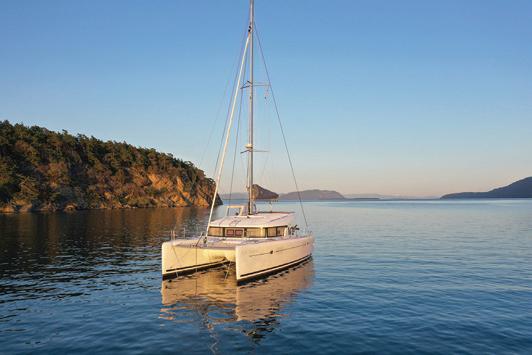
Evergreen-studded islands, abundant wildlife and peaceful anchorages. Experienced or new to boating, we can help you discover the joys of cruising the beautiful San Juan Islands! Beginner to advanced liveaboard courses. Sailboat and powerboat bareboat charters. Guided otillas too!

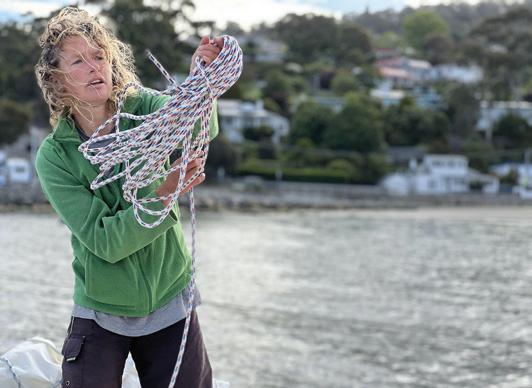
Kirsten sailed more than 15,000 solo ocean miles on Minnehaha before she even got to the starting line of the Golden Globe Race.
running parallel on those trips, but I was doing it with celestial. The difference when I left for the race is I didn’t have a GPS to verify my position. In the beginning, that made me a little bit anxious, like, “What if I get it wrong?” Especially in the Bay of Biscay and heading towards the Spanish coastline where there’s still land and you do have to get it right. I guess you settle into it.
Come back next month for more of Kirsten’s stories of the Golden Globe Race around the world!
Joe Cline is the Managing Editor of 48° North.

48º NORTH 37 APRIL 2024 sanjuansailing.com • 360-671-4300
INSTRUCTION • BAREBOAT CHARTER • BROKERAGE

PASSING CAPE CAUTION
GETTING TO AND AROUND THIS INFAMOUSLY CHALLENGING HEADLAND

 Aby William Kelly and Anne Vipond
Aby William Kelly and Anne Vipond
fter cruising the British Columbia and Alaska coasts for more than 40 years, we’ve reached the conclusion that some of the best cruising lies just north of Cape Caution. The problem is getting there, and then successfully rounding this notorious promontory.
British Columbia’s Cape Caution is at the southwest corner of the British Columbia mainland across Queen Charlotte Strait from the northern tip of Vancouver Island, where the more protected waters east of the island meet the Pacific Ocean.
Cape Caution is intimidating to many boaters, due in no small part to its reputation. Its notoriety is well earned— it is a significant cape that is exposed to Pacific Ocean swells arriving from hundreds of miles away. Rounding the cape is demanding, with challenges that include complex currents, strong winds, and frequent fog. A voyage to this cape should be founded on a few years of previous experience cruising southern waters.
The distance to Cape Caution from
48º NORTH 38 APRIL 2024
A windy day on Johnstone Strait.
the Canada/U.S. border in Haro Strait is about 250 nautical miles. In a typical 35foot sailboat, it will take about 10 days to get there. If time is limited, you should plan to travel at least 40 miles a day, allowing for two or three port stops if needed. Planning is critical, for there are few places to fuel up or buy provisions between Campbell River and Port McNeill. Marine parts are also scarce, so be sure to bring spares such as oil filters, pulley belts, impellers, and light bulbs— parts most cruisers already carry.
Other obstacles to reaching Cape Caution include the major passes and rapids north of Campbell River. Although most chartplotters will have tide and current information, we always carry printed copies of the Canadian Tide and Current Tables as well, which are available free online at: charts.gc.ca/ publications/tables-eng.html.
Boaters must have the proper Canadian charts (paper as well as electronic is best) and should carry the Sailing Directions for the British Columbia coast up to Fitz Hugh Sound. Various volumes of the SD are available at the above-noted website
and paper charts can be purchased at most chandleries.
ROUTE TO THE CAPE
Let’s start with the Strait of Georgia and a brief summary of the route we take to get to Cape Caution. If you’re traveling in a sailboat with a hull speed of under six or seven knots or a slower trawler, try as hard as you can to coordinate your travel with the tides. The flood tidal stream flows north in Georgia Strait until it meets the opposing flood current flowing south from Discovery Passage, about five miles south of Cape Mudge.
We try to arrive at Campbell River just as the north-flowing ebb in Discovery Passage is getting underway. Our preferred route heading north is Discovery Passage through Seymour Narrows. The pass is free of any obstructions and the only challenges are the currents—which can ramp up quickly to double digits—and commercial traffic such as tugs or cruise ships.
To transit this pass, we time our morning arrival at Seymour Narrows as the current is changing to a positive flow,
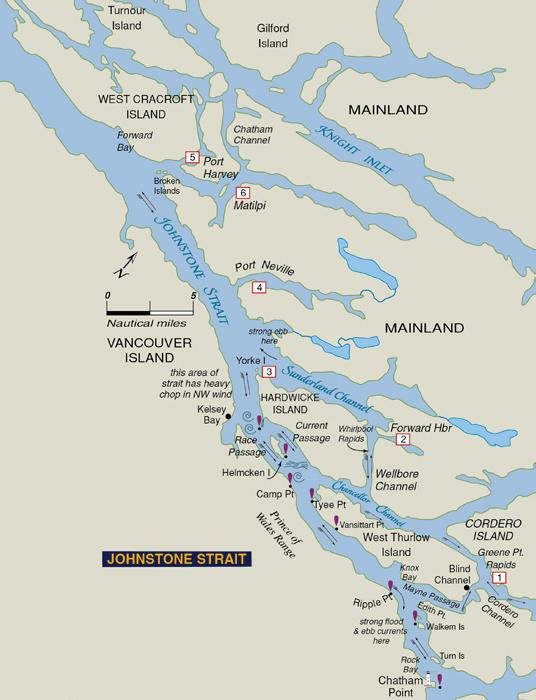
which is the north-flowing ebb. This way you’ll make good time getting to some nice anchorages at the top of Discovery Passage, such as Kanish Bay on Quadra Island or Handfield Bay on Sonora Island.
Once you’re in the proximity of Chatham Point, you’re at the mouth of Johnstone Strait—a rite of passage for boaters trying to get north. After you’ve had a few tussles with this strait’s often very strong breeze, you’ll understand one thing about northern voyages; none of them are easy.
The best way to master Johnstone Strait is to outfox the winds and, as with any fox, the key is to make your move either early in the morning or in the evening. Normally we try to leave our anchorage no later than seven in the morning. If the weather is sunny, westerly winds will often pick up by around nine o’clock and can be anywhere from 5 to 35 knots by noon. It’s always wise to stay up-todate with the typical slate of weather forecasting resources, but the previous day’s winds will also be a good indicator of coming wind strength, and monitoring the VHF weather station at Chatham Point


48º NORTH 39 APRIL 2024
Port McNeill is a great place to top up on food and fuel. Encountering fog is likely along the entire route north.


will give current conditions in the strait.
Getting from Chatham Point to Port Harvey is the goal and, since ebb current in Johnstone Strait flows in a northwest direction, catching an ebb will be very helpful, especially if the weather is fair so the impact of breeze-against-current will be reduced. This can be a nasty stretch of the strait so make as many miles as possible if conditions are good. Stay to the north side of the strait to get the most of the ebb.
There are places to duck out of the wind if things get too hectic, including Mayne Passage and the resort at Blind Channel or, a little farther north, Forward Harbour. There are passes in this area, including Current and Race Passage as well as Wellborne Channel and Whirlpool Rapids.
We often pull into either Port Neville or Port Harvey on the north side of Johnstone, but some of the strongest winds and steepest chop can be near Kelsey Bay on the south side, which, with its public dock, is another spot to seek refuge from poor conditions in the strait.
The objective is to get through

Johnstone Strait quickly and arrive at either Port McNeill or Port Hardy, both of which have good moorage and fuel facilities. These towns, roughly 20 miles apart on Vancouver Island, are our regular provisioning ports before heading past Cape Caution. Some boaters like to meander through the Broughton Archipelago and go up the mainland side to Blunden Harbour, which has no facilities but is a beautiful anchorage.
APPROACHING AND ROUNDING CAPE CAUTION
From Port McNeill, it’s about 45 miles to Cape Caution, but just a few miles south of the cape are some excellent anchorages where we sometimes stop to wait for favorable weather conditions or just enjoy the scenery. These include Allison Harbour, Murray Labyrinth, and Miles Inlet, all of which provide excellent shelter. Allison Harbour is easy to enter and large enough for several boats.
But the penultimate challenge upon leaving Port McNeill is getting across Queen Charlotte Strait, which is easier said than done. Westerlies can quickly
build and the other hazard is fog, which is common from late July to September and can persist daily into early afternoon. If fog or strong winds begin to develop and crossing the strait is not practical, there are several options to get out of the weather, such as anchoring in the lee of Peel Island in Beaver Harbour or pulling into Port Hardy. Another option is the Walker Group anchorage in the channel between Kent and Staples Islands.
You can get an idea if the day’s conditions are favorable for rounding Cape Caution from the reported wave height at the West Sea Otter buoy: if this is below one meter, the trip will be safe and relatively comfortable. We can attest to this. If higher than one meter, it usually means the wind has picked up and your boat will be rolling quite a bit past the cape as you head to Egg Island. West winds above 15 knots would also make us think twice and probably result in heading to an anchorage on the mainland side.
There are several routes to the cape. The most direct route from Port McNeill is a line from Malcolm Island that goes
48º NORTH 40 APRIL 2024
Port Harvey is a great place to tuck into if winds are strong in the strait.
If the weather for rounding the cape isn't good, Allison Harbour is a great place to wait.

between the Deserters Group and Echo Islands. This will take you close to Allan Rocks, which is a good waypoint, being near the entrances to Allison Harbour and Miles Inlet—great anchorages to pull into if conditions have deteriorated.
Another route for boaters wanting to avoid mainland current is plotting a course near Pine Island, following either Gordon Passage or Europa Passage. This route does, however, limit your options for ducking into a mainland anchorage in poor conditions.
The state of the tide is another factor. If a strong ebb is under way, the current coming out of Slingsby Channel will be significant and, if a west wind is blowing, the chop will be brutal near the entrance. Stay at least a mile or two off Fox Islands under such conditions.
When approaching Cape Caution for the first time, boaters are well advised to keep a mile or two off the cape, even

in settled weather. The bottom shelves quickly opposite the cape and can create conditions the cape is renowned for – steep sweeping seas as wind goes against current.
We used to sail west of Egg Island for a look at the lighthouse which is doable, but now we stay on the east side to get out of the waves and rolling seas. We also stay west of North and South Iron Rocks. Once past Egg and Table Islands, things slowly begin to moderate and you can lay a course for the cruising paradise of Fitz Hugh Sound. If conditions are worsening, a good nearby anchorage is Jones Cove in Smith Sound or farther east to Indian Channel or Takush Harbour.
Many boaters like to turn into Rivers Inlet, or go farther north to Penrose Island Marine Park and the anchorage north of Fury Island. If a strong southwest wind is forecast, Safety Cove is a good spot


to anchor. Beyond this lies a myriad of beautiful destinations, including Pruth Bay and Fish Egg Inlet.
Either way, congratulate yourself, you’ve made it around Cape Caution—an accomplishment in itself and a gateway to some of the world’s finest cruising grounds.
Award-winning authors William Kelly and Anne Vipond have written about cruising the B.C. Inside Passage for over 40 years. Their stories have appeared in yachting publications across North America. Their best-selling and awardwinning guidebook Best Anchorages of the Inside Passage—recently released in a revised second edition—covers anchorages from the Gulf Islands to Bella Bella and includes Desolation Sound and Broughton Archipelago. The book also covers pilotage to all the tidal passes leading to Cape Caution.

48º NORTH 41 APRIL 2024
A stroll on the beach at Calvert Island is a great reward after the trip north.
NxNW NORTHWEST RIGGING Rig locally Sail globally 360.293.1154 • www.nwrigging.com • info@nwrigging.com
Fury Island is a must-see destination north of Cape Caution.

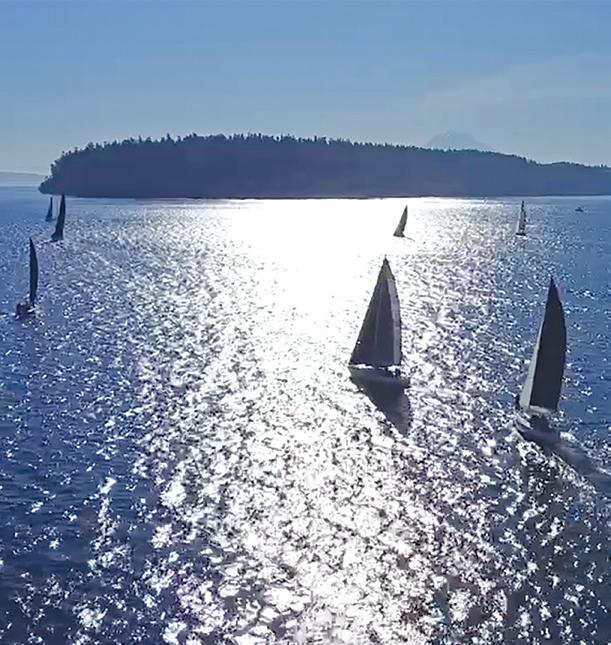
WELCOME TO SPRING
GIG HARBOR ISLANDS RACE
 by Peter Stewart
by Peter Stewart
The final race of the 2023-2024 Southern Sound Series took place out of picturesque Gig Harbor on Saturday, March 16. The forecast for light winds and sunshine provided a stark contrast to anyone who had been out for the previous week’s Possession Point Race with its stormy rain and ice pellets, and cells delivering 25 to 50 knots of wind.
We had been out racing the prior week on our Cal 33, Cherokee. We retired and fared well with minor mainsail damage and a broken spinnaker guy. Licking our wounds during the intervening week, I decided to pass on the Islands Race with Cherokee. But, with an invite to sail with friends on the Hobie 33, TC, I still got to go racing!
With the boat delivered, the crew caravaned to Gig Harbor under clear, sunny skies. Crossing the Narrows Bridge, we could see the light northerly was filling in. This was promising for the day ahead. Arriving at the boat, we had a main to bend on and sail selections to make. Relying on the light forecast, we decided to keep weight off the boat and only bring the #1 jib. Once on the course, we contemplated our start plan, asking ourselves if we would need a different headsail for more wind at the top of the course.
During the pre-start, PRO Charlie Rathkopf broadcasted a change of course over the VHF from the committee boat. Instead of sending the fleet all the way up to Blake Island, the course would be shortened with a turning mark about threequarters of the way up Colvos Passage. Hmm, maybe that light #1 would be fine?
Our crew watched the first starts and observed their performance, putting in our two-cents to the brain trust. TC is quite fast in these conditions, so we really needed to be able to tack when we wanted to. Watching the shifts during the sequence, John Hogue put TC down the line under everyone on time. Fully powered up by Paul Carter on the main and Ric Petersen trimming jib, TC was fast off the start sailing higher and faster than our class. JJ Hoag, Will Nelson, and I held down the rail and fed information.
Watching the usual suspects in preceding classes—Aurora and Tonic to name a few—we made a few tacks, picked shifts, and stayed mostly to the west shore of Colvos Passage. We had TC among the lead boats. A long port tack brought us over to the east shore south of Sandford Point. Tonic, Aurora, and Slick were exchanging tacks with us, as we tried to distance ourselves from Myrrh and Gnarwhal, some of our competitors in class PHRF 5. Looking back, we could see that our group had really gapped PHRF 2, 3, and most of PHRF 4. We caught a break and it was lightening to the south.
We battled Tonic, eventually passing them to round the windward mark in Fern Cove in first place. Selecting the S2, we sailed down the east shore along Vashon in current relief. Passing some earlier starters from the Commodores class, White Squall and BellaRose, it was clear the shore was working.
For a while we had extended on our class, then we sailed out of the northerly as a light southwest wind took over near the bottom of Colvos Passage. We swapped back to the light headsail, and we now had a stack of boats catching us, as we
48º NORTH 42 APRIL 2024
The TC crew in the zone, focusing in the light air.
Photo by Jonathan Salter.

tried to enter the newly forming wind pattern.
Up at the front of the fleet was now Myrrh, Flicka, Gnarwhal, TC, Slick, Sidewinder, and Panic. In the end, it paid to continue playing the beach the rest of the way to the finish line. Gnarwhal, Flicka, and Slick, led TC and Myrrh across the line. On corrected time, the top spot in our class went to Gnarwhal, followed by Myrrh and TC.
Around the fleet, class honors went to J/133 Constellation, Flying Tiger 10 Tigger, J/35 Flicka, J/29 Slick (who also won
The fleet learned of a course alteration during the pre-start. Photo
overall), and Ranger 33 Aurora. The Cruising and Commodores classes were won by Pearson 36 Koosah, Beneteau First 375 BellaRose, and C&C 34 Jolly Rumbalow
The boats that could finish within the next 30 minutes were very fortunate. The price of this beautiful coming spring was very slow sailing for those that kept racing. It was a gorgeous day with spectacular Mount Rainier and Olympic views to enjoy. Spring is here, what a difference a week makes!
Full results at: www.ssssclub.com/southern-sound-series-racing/

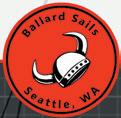
As great as 2023 was, the two doublehanded teams that make up the Red Ruby Project have big plans for the year ahead too!
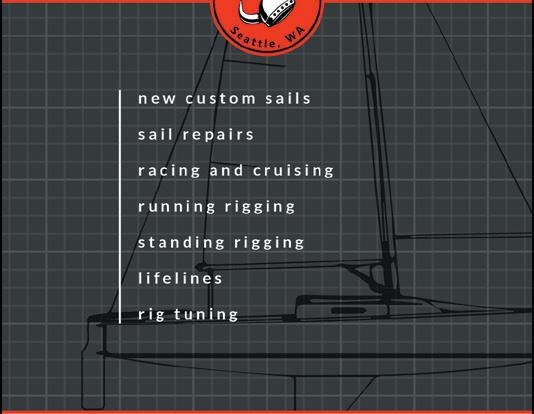


48º NORTH 43 APRIL 2024
from video taken by Jonathan Salter.
by Stephanie Campbell
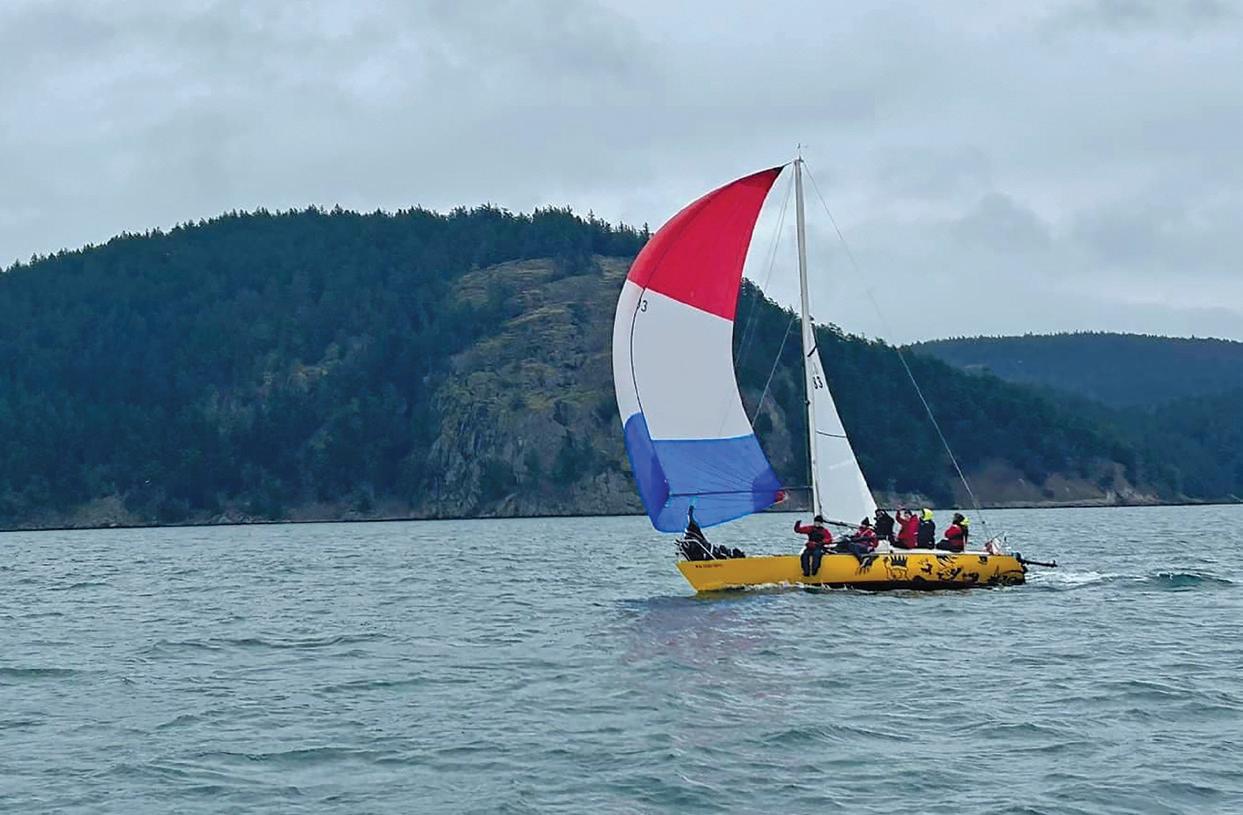
GIRTS REKEVICS MEMORIAL FOULWEATHER RACE 2024
Not everyone would understand why my living room looks the way it does right now, but I’ll bet there are a few people who do. The 2024 edition of the Girts Rekevics Memorial Foulweather Race featured enough breeze to break the Anacortes to Friday Harbor course record—18.5 miles in under 2 hours for the first finisher!
It was intermittently very windy and splashy and occasionally drifty at a few corners. Every single sail on board my Santa Cruz 27, Wild Rumpus, went up at one point or another, except for the sweet drifter. The storm jib only appeared on the trip home. Between rain squalls and standing waves, each and every sail has earned some quality time inside the house to dry out.
We started the race with solid close reaching conditions in Fidalgo Bay. The pin end boat, closest to weather, was the only one who elected to hoist a kite. Good morning, friends, you gotta keep things exciting! Some colorful words, but thankfully not colorful paint, were
exchanged at the starting line. Right out of the gate, there was an expected slow patch before we turned the corner to Guemes Channel. It wasn’t too long before we had to do a bare-headed drop to the small jib. Other boats were putting in reefs, and some boats just hunkered down and hiked out.
A strong ebb helped us fetch to Thatcher Pass without tacking, although the ebb stacked up some big waves that occasionally stuffed the bow. The mulithulls were launched, and the Burns 49 schooner Sir Isaac also sank her teeth into the big breeze and waves. On the good ship Wild Rumpus, we had already crossed Rosario Strait and we were only one hour into the race.
After a brief slow down at the corner of Blakely Island, we cracked off just enough that hoisting a kite seemed like a great idea during the lulls. Rumpus had some competition ahead of us that owed us time, we just didn’t know if we were close enough to correct in front. We had to make our spinnaker call work well enough to make up for the
inevitably sketchy douse in our future. The rest of the race was mostly upwind with at least one more sail change, lots of hiking out, and a little bit of ferry dodging. Not a course record but very fast for us, Rumpus finished over 18 miles in about three hours.
There was a big system predicted to blow in overnight, so many crews elected to turn and burn back to the barn after finishing the race in Friday Harbor. Nonetheless, the survivor party on the dock and at the San Juan Island Yacht Club was big fun and exactly how Girts would have wanted it. Multigenerational good times were had, chickens were flying, the lasagna was as yummy as we remembered, and the spirit of the event lives on!
Congratulations go out to Nigel Oswald and crew, winning the race for the second year in a row on his F25 Makika! He also saved the day with some much needed tech support. Second in the multihulls and overall went to Trevor DiMarco on Corsair 750 Trial Horse. First in PHRF1 and nipping at the heels of the
48º NORTH 44 APRIL 2024

multihulls were the Baileys on Sir Isaac First in PHRF2 went to the small but mighty Wild Rumpus. We had two intrepid doublehanded boats on the course, won by John Gunn on the Beneteau 265 Little Annie. Congratulations to all of this year’s participants!
True to the season and the event’s
tradition, this year’s Girts Rekevics Memorial Foulweather Race got a little spicy, and it was really the best of ‘Type II’ entertainment. Here’s to another season well on its way. If this race is any indication, 2024 is going to be a great year!
Full results at www.anacortesyachtclub.org








Presented by:
48º NORTH 45 APRIL 2024
June 15/16, 2024
l
Welcome l Shilshole Bay
All J Boats
Marina, Seattle
The Rumpus crew, ready for anything.
Jim Bottles' J/30 Celebration sailed fast and corrected just one minute behind Wild Rumpus for 2nd in class.
by Joe Cline
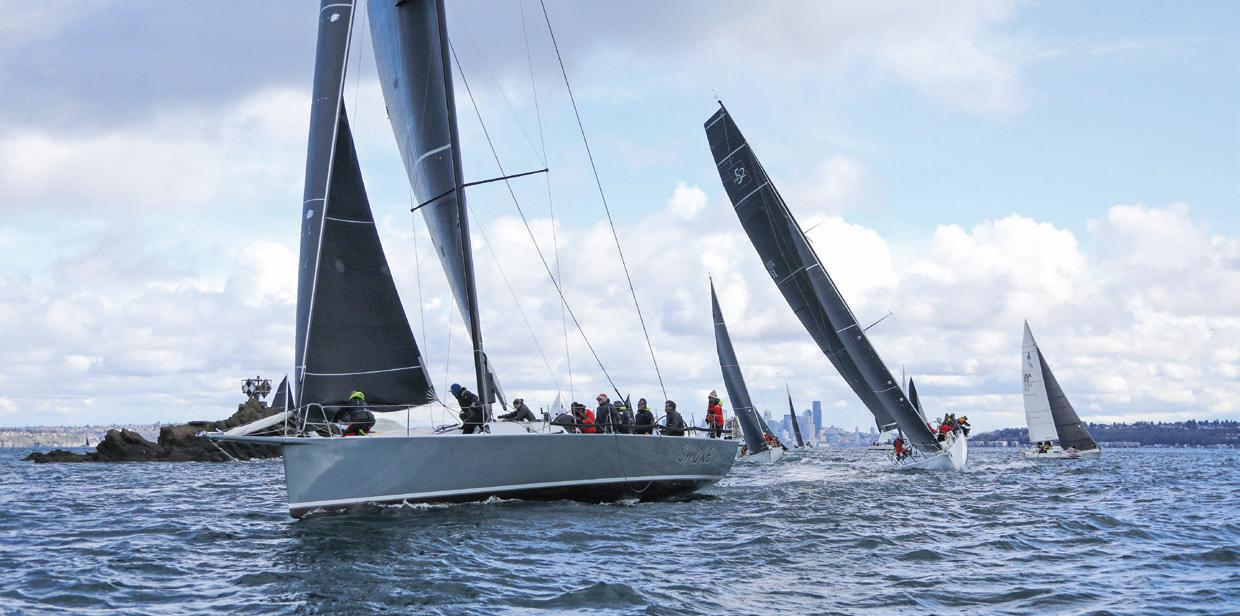
BLOWING DOGS OFF CHAINS
CENTER SOUND SERIES BLAKELY ROCK AND POSSESSION POINT RACES
Though like any day on the water in the Pacific Northwest there was meteorological variability aplenty, the top wind speeds recorded by race boats in Corinthian Yacht Club of Seattle’s March mid-distance trio—Center Sound Series—make this quite possibly the windiest start to Center Sound ever. The first of these brought sailors back to the dock grinning from ear to salt-encrusted ear. After the second race, sailors returned home grateful to have missed the worst of the blow or with an extremely real appreciation of how un-fun 50 knots of breeze is.
Among the always-competitive group of nine J/105s, Creative had the highest lane and cleanest air and seemed to benefit from it during most of the beat to Bainbridge. The boats behind them traded tacks in the shifting breeze on the west side of Puget Sound, with the first boat to tack on a westerly header, Panic, making gains and eventually rounding first.

J/99 One Life beating to Blakely in the building southerly.
The official spring kick-off of the racing season in the Seattle area, CYC’s Blakely Rock Race opened the series on March 2, with a forecast for fresh southerly breeze. Getting out to the starting area, the fleet of 52 boats ranging from 22.5-foot J/70s to TP52s set sails in 12-14 knots. Looking out from Shilshole to where the race course would bring them, they were able to see a southerly pushing toward 20 knots. The course brought them upwind to Blakely Rock, rounding it somewhat unusually to starboard, then downwind to a temporary mark near Edmonds, before a beat back to the start/finish line.
The navigator onboard TP52 Glory, Spencer Kunath, described the first leg as “a pretty classic beat to Blakely.” With the startline close to shore, it was just a short hitch on starboard toward the breakwater before tacking to ride the lifts along the beach toward West Point.
By the time the fleet reached “the Rock” the difficult choice was whether to hoist the kite on the port tack you’d be rounding on—leaving a pretty short runway before a jibe would be required—or jibe first and then hoist. Glory rounded first among the 52s and chose the port tack hoist, looking for the first available lane to jibe out. The J/105s were split, with some setting as they rounded, and others jibing first.
The clouds darkened and the wind built on the downwind leg—a whiteknuckle delight for the straight-line run, but also signaling a difficult heavy-air douse in everyone’s future (if they could find the mark, which proved a challenge for some). Glory needed only one step to the east, and enjoyed a ripping high for the day of 23 knots of boat speed with their A2 spinnaker, observing as much as 29 knots of breeze. In the fleets a little farther behind them, staying west where the breeze built paid off. A ways down the run, that’s where J/105 Moose Unknown was able to make up ground on their competitors who had rounded Blakely ahead of them.
The leeward mark rounding was as pivotal as it was nervy—
48º NORTH 46 APRIL 2024
The downwind start of the Possession Point Race was windy but manageable. Conditions would get unmanageable eventually.

dousing in 25-28 knots is always a bit exciting. Glory had a hiccup with their letterbox drop, but retained enough of their lead to carry on for the class and overall ORC win. After the rounding, Moose Unknown was able to fetch the finish in the breeze decreasing to 8-15 knots—they went on to class and overall wins under the PHRF handicap. In the end, Kunath summed up a very good day of early March racing, “You’d pay a lot of money to go do that race again.”
I’m not sure you could pay certain sailors to go back out for another round of the Possession Point Race on March 9, however. The fastest boats made it around the course from Shilshole Bay to the south end of Whidbey Island and back before the monster cell came in, but it was a very windy day that built to gear-bustingly massive.
Races like this year’s Possession Point are a reminder of the critical importance of all the thought and effort we put into making our boats, our crews, and ourselves safe on the water. There’s no way to predict exactly how or when the shit will hit the fan, but when it does, we rely on these various levels of preparation.
Many boats made the understandable choice to not even leave the dock with a forecast that ultimately undershot reality but still called for 30-40 knot gusts, yet 30 boats braved the March tempest. Safe seamanship was important even early on when the wind was only in the 15-25 knot range. Most notably, a crewmember went overboard from the J/105 Creative after a jibe with the kite up. Skipper Al Hughes wrote this on the J/105 Pacific Northwest fleet page: “Shortly after a jibe, we had a crew slide across the cabin top and right under the lifelines into the water. Turn up and a quick douse of the kite, good job crew! Tack around, circle the crew with the Lifesling, and we got them quickly back onboard with the transom ladder. Checked the crew physical and mental condition, put them down below with another crew for more assessment and continued on to the buoy. All reported fine below with fresh dry clothes and a strong desire to keep racing.” Those who know Al won’t be surprised by this undramatic matter-of-fact retelling, but an overboard situation with a kite up in conditions like these is a heavy scenario. Very well done to Al and the crew, securing the crew overboard so deftly—it could have been a scarier story.
Truly, the story of the race isn’t so much about the race, it’s about the survival conditions the back portion of the fleet experienced. After a day crewing and successfully finishing
Having a kite up in 25 knots made it a rowdy day for Sydney 41 Mystic, even before it got truly gnarly.
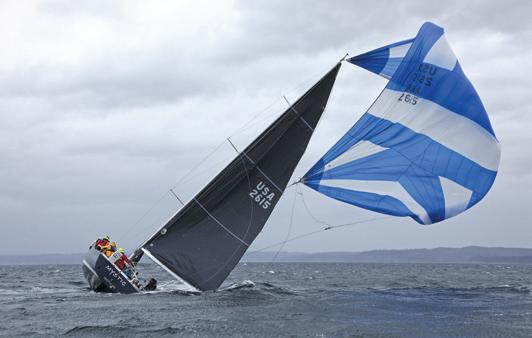
first-in-class on Derek DeCouteau’s Ranger 33, Aurora, our friend Kurt Hoehne wrote on his website Sailish.com: “Let’s just call it 50 knots of breeze. Anecdotally, reports came in of 50 knots of windspeed. Some said 48. On the water it seemed every bit of 50…. There was a distinct line of demarcation when the biggest wind hit—boats behind that line were scattered with ripped sails, crews on the foredeck holding downed headsails while hoping it would soon be over. Some boats were trying to motor under bare poles. Some limped to the finish after the worst of it passed. And the J/109 Eclipse broke her mast.”
In the end, it was a race and some boats did actually finish without incident. Scott Smith, one of the vastly experienced crew aboard the Farr 36, Annapurna, shared, “Everything that was thrown at us was handled in a calm, efficient manner and despite some not-so-normal conditions, all was good.” Overall honors for the day went to the J/111 Lodos in the ORC fleet and Hobie 33 TC amongst the PHRF boats. After a day like that, I’m mainly glad everyone is home safe, but congrats nonetheless to those who finished and finished well!
Woof, who knows what else March might hurl at these Center Sound racers. They’ve got one more event that will take place after this magazine goes to press. I bet I’m not the only one keeping fingers crossed for some blissful champagne sailing to round out the series. Or, sure, one more epic day to complete the set!
Results at cycseattle.org
Photos by Jan Anderson.
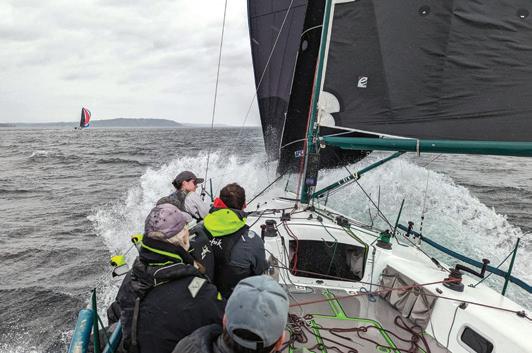
48º NORTH 47 APRIL 2024
Farr 36 Annapurna sailed fast and clean with an epic run to start, finishing before the heaviest air came in.
Photo by Scott Smith.

BOATS FOR SALE BOATS FOR SALE
$15,000

Owned since 2011. Solid Cruiser. Comfortable boat that will make a great live aboard. Located in Marina Fonatur, San Blas, Nayarit, Mexico. Ten-hour day sail South to Puerto Vallarta. Overnight sail North to Mazatlan. New stainless steel port lights. Reconditioned hatches. New instruments. Reconditioned engine. More Pictures: https://bit.ly/morgan462
» Contact Steve Koole • koolekat1958@hotmail.com
• $15,000
$38,500

Great couples/small fam boat. Vancouver Is vet. Good condition overall. Yanmar 2GM in V/G cond 1500 hr. 4 Sails all V/G Inc. “Assymetrial” & furling jib. Fresh auto/pilot. 5 yr old Radar/Garmin GPS. Windlass w/80’chain, 200ft 5/8” nylon. BBQ. 2018×4-115A Agm House. 240w Solar with upgr control 2019. New camper top 2023. Old beat up infl w/ excYamaha 2.5. New Rocna 25lb. Webasto Heat. Swim step. » Contact Richard or Christine Epstein • (360) 661-7370 • Eppy56@icloud.com • $38,500
$259,500

Roomy family fun, high efficiency, seakindly. AK vet. Sleeps 6. Salon w/fireplace. Good 4 liveaboard. 5 rooms. EZ maintained woody/snap on covers. All bronze fastened. NWSWB. New 12" Garmin, digital radar, depth. Fishfinder, Autopilot, AIS, Cell extend, VHF’s. 2 helms. 6.75 kt cruising, 48+hp diesel. Furling jib. MaxProp. Solar. Rocna. Achilles. Refer, Frzr, Dickinson & summer stoves. Oly slip $350. www.decarbthepassage.net
» Contact Peter Wilcox • (503) 490-5407
• Peter@decarbthepassage.com • $259,500

PASSPORT 40 1983
World Capable Cruiser. Ready to take you cruising. Beautiful yacht. Cutter rigged with oversized rigging and extra cockpit winches. Lots of newer equipment; 40 hp Yanmar engine, autopilot, radar, stove/oven, watermaker. Cruise equipped; large sail inventory, windvane, heater, fridge/freezer. 2018, engine and power train refurbished at $20K cost. Orcas Island, WA. » Contact Tom Owens • (360) 632-8896
• svlandsend@yahoo.com • $115,000
$150,000
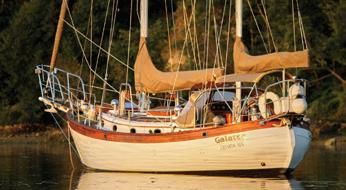
Embark on a journey with this distinctive 1980 Hans Christian 43T, a maritime masterpiece crafted for those who seek the perfect blend of timeless elegance and proven seaworthiness. Moored in Santa Barbara, CA she has been continuously upgraded. Sell Sheet: https://masonphotography.photoshelter.com/gallery/ Galatea/G00001XXSAcsRE0E » Contact Steve Mason • (360) 607-8400 • masonimage@mac.com • $150,000

VENTURE
OF NEWPORT 23
Very nice trailerable sailboat. I get constant compliments from people who didn’t know MacGregor made such a handsome, jaunty, and sassy looking model. All exterior wood is teak. About the lightest towing weight of any boat this capacious. Good condition. Sunbrella covered cushions. Everything works. Great galvanized roller trailer. Boat can be sold separately. See specs and many photos online.
» Contact Richard Dodge • 1(206) 954-7208 (Send text) • dodgerichard027@gmail.com • $4,499
BOATS FOR SALE
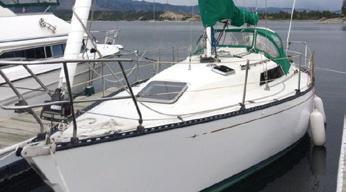
33 FOOT C & C
Well equipped C&C 33 foot MK11 with trailer. Minor repairs needed. Worth $35,000, asking $25,000. Will consider reasonable offers. » Contact Jan Martin • (406) 459-3339 • jomvallymt@gmail.com • $25,000

28' BRISTOL CHANNEL CUTTER
Built 1986 by the Sam Morse Co. Volvo D1-30 28hp low hours. Diesel bulkhead heater, Monitor windvane, 3 burner Force 10 propane stove with oven and broiler. Jib, staysail, mainsail, drifter, storm jib, storm trysail. Located Sitka, AK. Details at bristolchannelcutterforsale.com
» Contact John Herchenrider • (907) 752-5033
• johnherch@gmail.com • $69,000
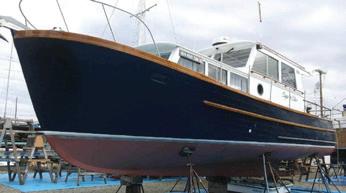
Cruise 8k, plane to 15k. Fiberglass hull. 6cyl turbo diesel, 3500 hrs. New Raymarine chart plotter. Radar, AIS, 3000w inverter. Maxwell electric windless, 200’ chain. Solar panels. Tecma electric toilet, 35 gal holding tank, 200 gal diesel, Propane stove and Cozy Cabin heater. Reefer/ freezer. Recent Survey. Located in Pleasant Harbor WA. » Contact Brad • (360) 774-0912
• carreirasuzanne@yahoo.com • $52,000
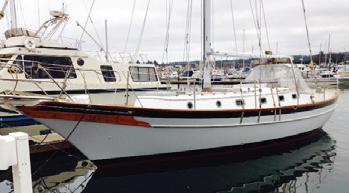
CABO RICO 38
Excellent boat for a couple to cruise. We have cruised her over 10,000 miles, and her previous owner sailed her to the South Pacific (Australia) and back. She has been well maintained over all that time. Easy to sail, comfortable, and safe boat to cruise. World class designed and built to the highest standards.
» Contact George P Leonnig • 1(503) 707-6062
• moctobi@gmail.com • $70,000
48º NORTH 48 APRIL 2024
2008 36' GAFF KETCH MOTORSAILER
$25,000
46.5' MORGAN 462 (1981)
HUNTER 33.5 LEGEND SERIES
CLASSIC HANS CHRISTIAN 43T STAYSAIL KETCH
36’ ROUGHWATER CRUISER 1981
$52,000
$70,000
$115,000
$4,499
$69,000
CLASSIFIEDS
$72,900

CUSTOM 43’ EDSON SCHOCK KETCH (1973)
Professionally built of mahogany planking over oak frames, Debonair has been lovingly maintained. Extensive upgrades include new electrical and 75hp Yanmar. Consistently turning heads, Debonair is a seaworthy passage-maker, recently completing a 16,000nm tour of the South and North Pacific. From rig to sails, systems to safety, Debonair is voyage-ready. Details: porttownsendboatco.com or www.yachtworld.com/yacht/1973-custom-edsonschock-43'-ketch-8441971/ » Contact Vance Rucker • ketchdebonair@gmail.com • $72,900
$189,500

BEAUTIFUL 2008 BENETEAU OCEANIS 40 FOR SALE
Beautiful 2008 Beneteau 40 owners addition. Second owner with many recent upgrades, vessel is in excellent condition with too many extras to name. New Balmar 170 amp alternator with regulator and new wiring. New organic latex mattress with bamboo topper. New 12-inch Raymarine Axiom GPS. Send and Receive AIS, Radar, teak in excellent condition. Ready to take you anywhere. Located in Bellingham WA
» Contact Donald Goldberg • (541) 621-3797 • donbgoldberg@gmail.com • $189,500

BEYOND THE END OF THE WORLD
Explore
Land of Fire and Antarctic with Pacific NW Sailing! Join our 2024-2025 sailing expeditions on ice-class sailboats: Chile Patagonia Fiords (12 days), Cape Horn and Patagonia Fiords (12 days), Antarctic (16-21 days). ASA sailing courses available during expeditions. For detailed information, text or email at info@PNWSail.co » Contact Vladimir Chepurnoi (Captain, ASA Instructor) • (425) 365-7890 • vlad@pnwsail.co



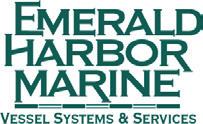

44


48º NORTH 49 APRIL 2024
BOATS FOR SALE
For even more photos and listings check out 48north.com/classifieds EXCURSIONS
• $3,500 $3,500 INSTRUCTION Basic through Advanced Sailing Lessons Week-long Cruise & Learn lessons Spinnaker, Intro and Advance Racing Classes Gill foulweather gear & Dubarry footwear 206-782-5100 www.seattlesailing.com info@seattlesailing.com 7001 Seaview Ave NW Suite 130 (Shilshole Bay Marina in Port of Seattle Building) MOORAGE LIBERTY BAY MARINA 40’ – 48’ – 60’ slips. Great location in Poulsbo, WA Restrooms, Showers. Call the Marina Manager for availability and waitlist options: 360-779-7762 American Sailing Association courses Basic Keelboat 101 through Advanced Coastal 206 Based in Beautiful Anacortes, WA www.sailtime.com/anacortes/sailing-school info@seattleyachts.com 360-299-0777 VESSEL MOVING No ocean too big, no trip too small, no ship too large, no mast too tall, sail or power, we move them all!!! When you are ready, give us a call. Professional service since 1967. CappyTom@aol.com • (206) 390- 1596 PROFESSIONAL SERVICES Full service rig shop serving Puget Sound www.evergreenrigging.com Cliff Hennen (360) 207-5016 • (206) 718-5582 The Systems Specialists www.emharbor.com Please contact us to arrange a visit: 206-285-3632 E-mail: info@emharbor.com Electronics E-mail: larry@emharbor.com Based at Elliott Bay Marina MARINE EQUIPMENT
the
FOOT SLIP FOR SALE SEMIAHMOO MARINA
location for access to San Juans and Gulf Islands at Semiahmoo Marina a best class marina. Slip C-18 is close to main dock and bathhouse with bow in starboard tie and allows 46’ maximum overall with 14.3’ beam. More info at: https://semiahmoomarina.com/ classifieds/c-18-44-is-fresh-on-the-market-115000/ » Contact John Cavanaugh • (360) 672-2760 • johncavanaugh@boatsafloat2.com • $105,000 VIKING 6 MAN LIFE RAFT Viking 6 person RecsYou Coastal Life raft. Never used. Service check indicated March 2024. Weight 28 Kg in Valise soft side container. » Contact Robert Hepple • 1(360) 306-0953 • a64me@yahoo.com • $1,200 $1,200
Great

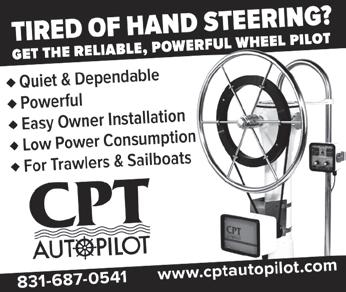



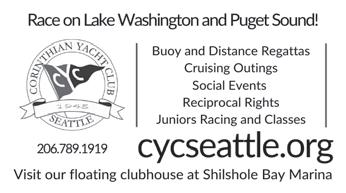


48º NORTH 50 APRIL 2024 CLUBS CROSSWORD SOLUTION PLEASE SUPPORT THE ADVERTISERS WHO BRING YOU 48° NORTH ACI Boats/Goldstar 29 Anacortes Chamber of Commerce 15 Anacortes Race Week 9 Ballard Sails & Yacht Repair 43 Beta Marine West 10 Boat US 11 Cape George Marine Works 19 Ocean Cruise Guides ................................ 23 CSR Marine ................................................. 43 Drivelines NW ............................................ 29 Duckworks .................................................. 17 Elliott Bay Yacht Sales.............................. 51 Fisheries Supply ...........................................4 Iverson's Design ........................................ 41 J/Fest............................................................ 45 Marine Servicenter 56 Marine Thrift 52 Northwest Marine Trade Association 19 Northwest Maritime Center 29, 52 Northwest Rigging 41 Northwest Yacht Brokers Association 17 Port of Friday Harbor 29 Port of Port Townsend 8 Port Townsend Rigging 23 Port Townsend Shipwrights 33 Royal Victoria Yacht Club 12 Sail Northwest 2 Sailrite 7 San Juan Sailing ........................................ 37 Seattle Sailing Club .....................................3 Seattle Yachts ............................................ 54 Seventh Wave Marine .............................. 15 Signature Yachts........................................ 55 Sound Sailing ............................................. 37 Swiftsure Yachts ........................................ 53 Ullman Sails ............................................... 19 Waterline Boats 52 Yachtfinders/ Windseekers 51 MARINE EQUIPMENT MARINE EQUIPMENT Basic through Advanced Sailing Lessons Week-long Cruise & Learn lessons Spinnaker, Intro and Advance Racing Classes Gill foulweather gear & Dubarry footwear 206-782-5100 www.seattlesailing.com info@seattlesailing.com 7001 Seaview Ave NW Suite 130 (Shilshole Bay Marina in Port of Seattle Building) Fractional Membership makes boating affordable & easy! Your boat is ready when you are! https://sailtime.com/location/anacortes info@seattleyachts.com 360-299-0777 HULL COMPASS E I B L O P LEEWARD TRIMS M T T S N A BOATYARD DIM B E L E R P ORG NET BAITS W L T A FRO SEAANCHOR TON P C E K UP RBI HEAVINGTO I E EVEN E S TURNKEY GREET 12 3 456 7 89 10 11 12 13 14 15 16 17 18 19 20 21 22 23 24 25 26 27 28 29 30 31 32 33 509.928.1964 Asymetrical drifters & spinnakers Classic Sails (Gaff, Sprit & Lugs) Performance furling & G-SpinnTM Sails Light Air Sails we design & make custom sails in washington state! YAGERSAILS.COM FLYINGSAILS.NET NW Sail and Canvas Makers YAGER SAILS & CANVAS


(619) 224-2349 • Fax (619) 224-4692 • 2330 Shelter Island Dr. #207 San Diego, CA 92106 www.yachtfinders.biz • info@yachtfinders.biz

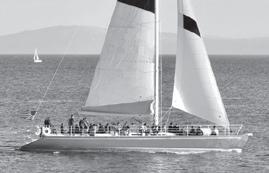


70’ SANTA CRUZ 70 ’85
.................... $325,000
“CHARDONNAY III” Turnkey Subchapter T vessel ready for charter business. Great opportunity to obtain a swift sailing passengers-for-hire boat
54’
ROBERTS 54 ’79
.................... $225,000
“SPIRIT” Rugged bluewater vessel designed with comfort and safety in mind. Nicely upgraded.Coast Guard Certified for up to 42 passengers.
40’ J BOATS J/120 ’98
.................... $119,000
“KRAKEN” A delight to sail. Excellent choice for around the buoy or offshore racing as well as short-handed coastal cruising. Come see!

42’ FORMOSA 42 ’82 $57,500 “ZEPHYRUS” Long range cruiser with beautiful teak below and lots of storage. Two staterooms and convertible salon.
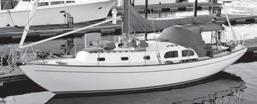
38’ PEARSON INVICTA II ’66 $49,500 “JIGGER” Custom companionway, interior upgrades, newer standing rigging and Yanmar diesel. A real treat!
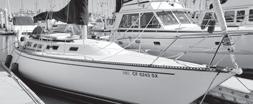
38’ CATALINA 38 ’83 $39,500 “MEANDROS”The ultimate cruiser/racer. Classic lines, recent sails and a spacious and beautifully updated interior.

36’ CATALINA 36 ’84 $48,000 “THOR’S REFUGE” This popular Frank Butler design has been mostly used for day sails. Monterey berth is transferable.
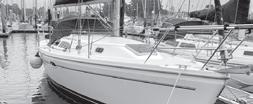
31’ CATALINA 310 ’00 $59,900 “HARMONY” Well-kept boat with large interior space. Island queen bed in owners’ cabin. One year slip possible.
THINKING OF SELLING YOUR BOAT? LET US HELP!
Power or Sail, we have buyers waiting! Call: 619.224.2349 or email: info@yachtfinders.biz

48º NORTH 51 APRIL 2024
Leader in Brokerage Sales on the West Coast
A
Professionally staffed! Open 6 days, Sun by appt.
SANTACRUZ REDUCED
MONTEREY




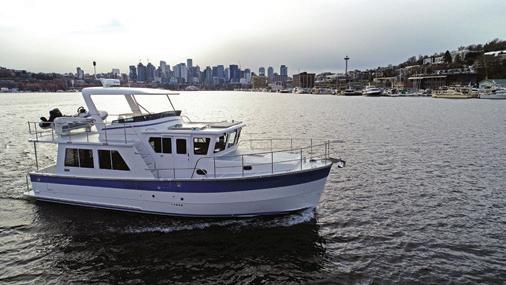
Heard
the docks — from people who’ve toured a Helmsman Trawlers®
43E
“Look how beautifully built this is”. ”It is so well thought-out”. “I love the real wood”. “The pilothouse works as a separate living area”. “The flybridge is big!”
Helmsman Trawlers are built to exceptional standards – examine and compare!



48º NORTH 52 APRIL 2024 46 - 43E - 43S - 38E - 38S Helmsman trawlers ® WATERLINEBOATS.COM | 206.282.0110 - SEATTLE | 425.278.9846 - EVERETT | 564.218.5201 - PORT TOWNSEND 1985 CHB 41
1978 MARINE
40
CLASSIC
31 helmsmantrawlers.com | 206 282 0110 WLB Brokerage - boatshed seattle . boatshed tacoma boatshed everett boatshed porttownsend WATERLINE BOATS WLB homeport for helmsman trawlers View our entire inventory of boats for sale at waterlineboats.com
EUROPA
TRADER
EUROPA 1987 GRAND BANKS 36
2017 HELMSMAN TRAWLERS
on
Pilothouse:
NORTHWEST MARITIME CENTER 431 Water Street Port Townsend, WA 98368 Breathtaking setting, spectacular day! Ceremonies Receptions Rehearsals Contact us today venuerentals@nwmaritime.org



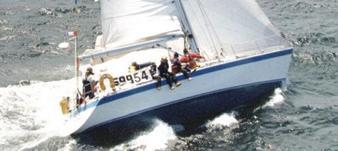
Micah Rose
Radford 14 Meter 2000 • inquire
Micah Rose is a robust, proven 46-foot aluminum passagemaker from the design board of Graham Radford. Relatively narrow beam and stability ensure excellent seakindliness and comfortable passagemaking. An extended pilothouse provides exceptional visibility, perfect for cruising the Alaskan waters she currently calls home. Micah Rose has cruised the Pacific to New Zealand and back, and has served as a comfortable Alaska home for a family of four for two years. Micah Rose has been diligently cared for by her hands-on owner and features upgraded electronics and a newer Yanmar diesel with only 1300 hours. This is a rare opportunity to step into a well designed and built, go-anywhere aluminum cruiser. The pilothouse setup is perfect for cruising the beautiful areas of the world that may not always have the driest and warmest weather!
– kurt hoenhe
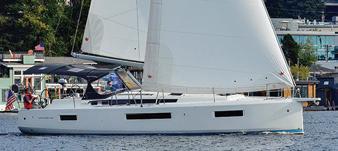

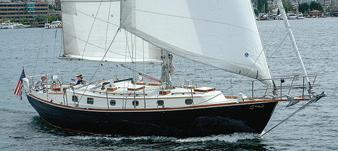



48º NORTH 53 APRIL 2024 QUALITY YACHTS FROM SWIFTSUREYACHTS.COM NEW YACHTS FOR WORLD CRUISING SwiftsureYachts www.swiftsureyachts.com 206.378.1110 | info@swiftsureyachts.com 2540 Westlake Ave. N., Ste. A Seattle, WA 98109 facebook.com/swiftsureyachts Seattle & Pacific Northwest San Francisco Bay Rhode Island With brokers on both west and east coasts, Swiftsure Yachts is dedicated to providing premium service to sailors buying or selling quality yachts. swiftsure locations
Morgan 440 • 2005 • $202,000
46 • 2003 • $420,000 Beneteau 473 • 2005 • $203,000 price reduced
48 • 2005 • $399,000
440 • 2020 • $429,000 70 Wylie 1993 $279,000 59 Hinckley Sou’wester 1997 $524,000 56 Coastal Craft 2012 $1,750,000 52 Santa Cruz 2001 $399,000 49 Hylas 2000 $399,000 49 Bavaria 2003 $189,000 48 OceanAlexanderAltus 2003 $399,000 48 Perry PH 1995 $289,000 45 Garcia Exploration 2025 €709,498 45 Allures 45.9 2021 $699,000 45 Freedom 1989 $154,000 44 Elan 45.1 2021 €265,000 44 Gib’Sea 126 1986 $74,500
Irwin 1987 $150,000
Catalina 42 (MKII) 2007 $185,000
Catalina
Hallberg-Rassy
Tayana
Jeanneau
43
42
48 • 2003 • $299,000 Shannon 43 • 1995 • $175,000 Wauquiez Centurion 40 • 1991 • $109,500
Seguin 44 • 1982 • $168,000 42 Valiant 2008 $284,000 42 Valiant 2008 $289,000 41 Sceptre 1989 $149,000 38 Catalina 1998 $109,000 36 Sabre 362 1996 $135,000 35 Shaw Riptide 1996 $145,000 35 Catalina 350 2003 $107,000 35 Hunter 35.5 1995 $42,500 35 Duffy 1998 $185,000 34 Jeanneau 34.2 2001 $79,000 28 Alerion Express 2000 $62,500 28 Cutwater 2013 $149,000 27 Ranger Tug 2018 $159,000 23 Ranger Tug 2017 $107,900
Saga
Lyman-Morse
price reduced price reduced price reduced


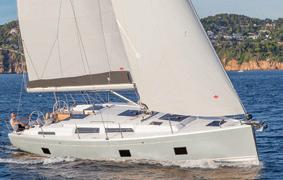










48º NORTH 54 APRIL 2024 844.692.2487 SEATTLEYACHTS.COM LIVE THE ADVENTURE SEA BEYOND WASHINGTON • CALIFORNIA • FLORIDA • MARYLAND • CANADA 2022 Tartan 365 #5 - DEMO BOAT Seattle Yachts 844.692.2487 2023 Excess 11 $581,884 Seattle Yachts 844.692.2487 IN-STOCK #70 2007 Hylas 49 $525,000 Greg Farah 360.603.0809 '08 Island Packet 370 $239,000 Jeff Gleckler 360.202.2290 Seattle Yachts 844.692.2487 2008 Beneteau 49 $299,000 Jeff Gleckler 360.202.2290 SELL YOUR BOAT! LIST WITH US! 2023 Hanse 418 $459,597 Seattle Yachts 844.692.2487 2024 Tartan 455 Seattle Yachts 844.692.2487 SUMMER 2024 #02 2022 Hanse 418 - DEMO BOAT Seattle Yachts 844.692.2487 IN-STOCK #304 IN-STOCK #05 IN-STOCK #288





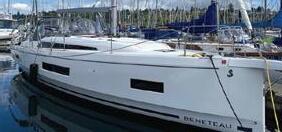
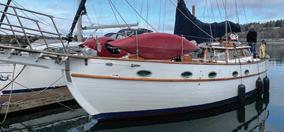

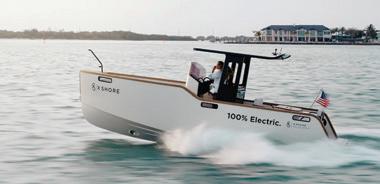

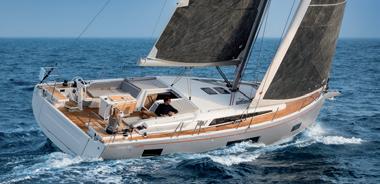

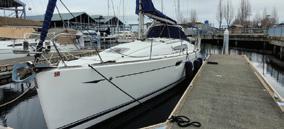




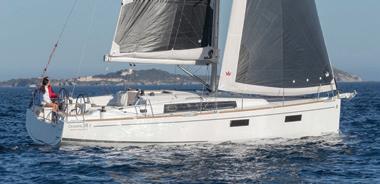
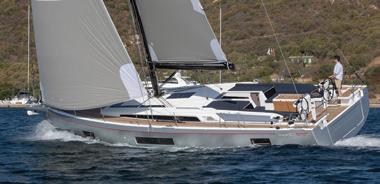


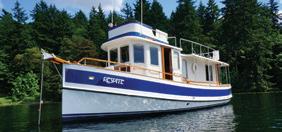



48º NORTH 55 APRIL 2024 Pre-owned Boats 68' Nordhaven 68 '11 ���������������������$3,600,000 ByAppointment 39' Jeanneau Sun Odyssey 39i '07 $154,500 AtOurDocks 40' Beneteau Oceanis 40 1 '23 $415,000 PriceDrop 38' Beneteau Oceanis 38 1 '21 $299,000 AtOurDocks 38' Globe 38 '83 �������������������������������� $114,500 AtOurDocks Beneteau Oceanis 34.1 Beneteau Oceanis 37.1 Beneteau Oceanis 46.1 X Shore 1 Beneteau Oceanis 40.1 X Shore Eelex 8000 Beneteau Oceanis 38.1 Beneteau First 27 Beneteau Oceanis 51.1 Arriving WestCoastDebut InStock TwoInStock TwoInStock InStock InStock InStock InStock What's Happening • Boats are Selling FAST! Quality Listings Wanted! Beneteau First 27 SE '23 Arriving Sold Beneteau 34 1 '24 Arriving Sold Beneteau Oceanis 30 1 '23 Arriving Sold Beneteau Oceanis 30 1 '23 Arriving Sold X Shore 1 '24 Arriving Sold Beneteau 46 '12 SOLD Beneteau 381 '99 SOLD Sabre 45 '19 SOLD Hunter Legend 37 '89 SOLD Beneteau Oceanis 30 1 '20 Sale Pending Ranger Tug R-31 S '13 Sale Pending 25' Chris Craft Corsair 25 '07 $68,500 2476 Westlake Ave N. #101, Seattle, WA 98109 • (206) 284-9004 • Open Mon-Sat 10:00am-5:00pm • Sun. by appointment WWW.SIGNATURE-YACHTS.COM 47' Beneteau 473 '01 $179,900 AtOurDocks 44' Island Packet 440 '07 $425,000 ByAppointment 36' Beneteau 361 '00 $99,900 AtOurDocks 46' Beneteau 46 1 '23 $599,000 ByAppointment 35' Beneteau 350 '88 $45,000 ByAppointment 40' Gozzard Pilgrim 40 '87 ������������������ $169,900 ByAppointment 45' Bayliner 4588 '86 ������������������������ $115,000 PriceDrop






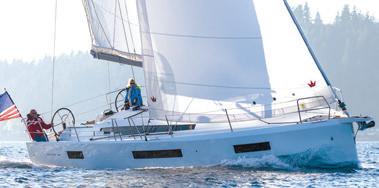




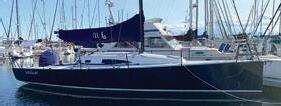














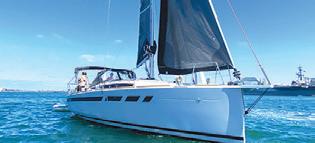
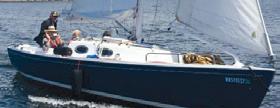





















48º NORTH 56 APRIL 2024 MARINE SERVICENTER 2023 Jeanneau 410 #77420: $399,875 Don Smith Dean Iwata Curt Bagley 2024 Lagoon 42 #835: $789,828 1988 Bristol Channel Cut. 28 • $92,000 Dealer of the Year ‘23 • ‘22 • ‘21 • ‘20 • ‘19 • ‘16 2024 Jeanneau 380 #77927: $378,535 2023 Jeanneau 490 #77424: $599,896 2011 Dufour 525 GL • $385,000 2011 J/111 • $269,900 1996 X-Yachts IMX 38 • $55,000 Reduced 1990 Jeanneau Sun Magic 44 • $109,500 LISTINGS WANTED! • WE GET RESULTS ! See Your Boat in 48° North & Five Online ads! 43' Jeanneau 43DS '03 ............ Sale Pending 41' Jeanneau 410 ‘20 Sale Pending 40' Jeanneau 409 ‘13 ........................... SOLD 40' Jeanneau 40DS ‘99 ............ Sale Pending 38' C&C MkIII ‘86 Sale Pending 38' C&C 115 '06 .................................... SOLD 37' Jeanneau SO37 ‘01 ............ Sale Pending 36' Islander 36 '75 New Listing $19,500 36' Catalina 36 ‘94 ............................... SOLD 35’ Catalina 350 ‘03 SOLD 35' Jeanneau 349 ‘20 SOLD 34' Bavaria 34 '01 .................... Sale Pending 33' Bavaria 33 '06 Sale Pending 33' Nauticat 33 ‘86 SOLD 32' Catalina 320 ‘00 ............................ SOLD Dan Krier Jeff Carson John Sheppard Yacht Sales - Since 1977 SAVE $138,379! SAVE $71,815! 2024 Jeanneau 349 Ltd Ed #77925: $259,990 SAVE $22,660! SAVE $99,839! SAVE $21,785! 2024 Catalina 355 #182: $358,746 SAVE $6,549 SAVE $16,492 1979 Morgan 382 • $154,900 LA MARE HOUSEBOATS Seattle Bellingham Los Angeles San Diego 2442 Westlake Ave. N 1801 Roeder Ave. #128 4655 Admiralty Way, #208 955 Harbor Island Dr., #160 206.323.2405 360.770.0180 310.963.3750 619.733.0559 info@marinesc.com • www.marinesc.com 2024 Jeanneau 440 #77930: $549,684 SAVE $36,709! 2014 Harbor 25 • $45,900 2022 Marshall Catboat 22 • $89,900 1994 Tofinou 23 • $37,000 New Listing 2024 LaMare Modern 11 #442: $329,834 2014 Jeanneau 409 • $214,500 New Listing Reduced APRIL 25-28 2022 Jeanneau 349 • $239,500 New Listing



















































































 by Solvig Sayre
by Solvig Sayre






















































 Aby William Kelly and Anne Vipond
Aby William Kelly and Anne Vipond













 by Peter Stewart
by Peter Stewart















































































































































